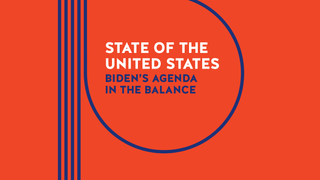Preface
Australia’s long-standing strategic relationship with the United States is transforming. Two factors are driving this change.
First is the pace and intensity of global geostrategic change centred on the Indo-Pacific. Not since the Second World War has Australia found itself so proximate to shifts in national power and capability, nor with as much at stake. Technological changes and economic interdependence have reshaped the nature of interstate competition. Projections of state power take a myriad of forms, presenting Australia strategic challenges and opportunities across multiple domains.
Second, the United States remains consumed by a fractious debate about its role in the world and almost paralysed by disunity. While policy elites from both sides of American politics aspire to make the Indo-Pacific the primary geostrategic focus of the United States, policy detail and tangible action is slow to emerge. Domestic politics, Europe and the Middle East compete with the Indo-Pacific for US strategic and operational focus. This was true under the Obama administration, the Trump administration and remains our assessment today, just over a year into the Biden administration. The Quad and AUKUS are welcome and positive developments, but work is still needed to realise their potential for contributing to Australian security and prosperity.
As we complete this volume, Russia has invaded Ukraine and the mettle of US alliances are being tested in ways not seen since before the Cold War. Because Australia’s relationship with the United States is its most important strategic asset, the US focus and pull towards Europe carries significant implications for Australia. The attitudes and sentiment we surveyed in our polling predate this conflict, but provide important insights into how the American people may react and, therefore, inform the Biden administration’s approach toward juggling international challenges while facing a crucial domestic election.
This volume, State of the United States: Biden’s agenda in the balance, analyses these drivers for change and the resulting implications for Australia. Consistent with the Centre’s mission, we build on this analysis to advocate a positive potential for advancing an agenda for the US-Australian alliance in this critical phase.
Professor Simon Jackman
Chief Executive Officer
March 2022
Executive summary
Where the United States was a year ago
In January 2021 alone, a deadly insurrection overtook the US Capitol for the first time in US history, a record 96,654 Americans died from COVID-19, and Joseph R. Biden Jr became the 46th president of the United States.
A few weeks later the United States Studies Centre (USSC) published its inaugural State of the United States, with the theme “An evolving alliance agenda.” Key elements of that report were:
- Predicting that as much as Australia might have feared becoming a target of the Biden administration’s climate agenda, US political realities would “limit broader congressional legislation on climate change” and that such differences would “not in any way threaten the deep fundamental relationship between the two countries” because the administration’s efforts would mostly be limited to executive orders and rhetoric. This insight has proven correct.
- Cautioning that trade would “not be an urgent priority for the administration relative to domestic issues” since actualised by the Biden administration leaving intact much of the Trump administration’s protectionist and inward-focused trade policies.
- Urging Australia to pursue “innovative ways to advance defence industry integration with the United States, including by coordinating with Canada and the United Kingdom” — the sort of integration now sought through the AUKUS agreement.
- Warning that ever-deepening political polarisation would constrain much of the Biden administration’s ambitious agenda to a few key areas: an infrastructure package as well as domestic and defence investments, which help the United States compete with and better address the China challenge.1
When asked at the launch event for State of the United States in March 2021 how the US Government envisioned a pathway for an ambitious Biden administration agenda amid such overwhelming political unrest, the State Department’s Deputy Assistant Secretary of State Atul Keshap posited that, “America is a society that is constantly innovating and reinventing itself. We’re kind of like that wobble doll, where you punch it and then it sort of wobbles back at you. There’s a lot of resiliency.”2
Keshap’s optimism mirrors that of Joe Biden himself, who famously said while campaigning for president in 2019 that Republicans would have an “epiphany” and turn away from Donald Trump once he was out of office.3
Alas, our analysis leads us to a different conclusion, and one with some bracing implications for Australian policymakers and strategic thinkers.
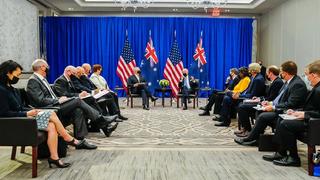
The State of the United States in 2022
This year’s State of the United States makes clear that, contrary to the optimists’ hopes, America has neither “wobbled back” nor experienced any epiphanies.
A year after what many considered one of the darkest periods in US history sees the United States experiencing the worst inflation in 40 years, more US deaths from COVID-19 occurring during the Biden administration than the Trump administration, the prospect of the biggest European land war since the Second World War, and the capital cities of its closest allies experiencing “American-style” protests over personal freedoms — Australia included.
Despite several important accomplishments in their first year in office, much of the ambitious Biden agenda remains unfulfilled, with the administration’s political capital exhausted.
Our State of the United States volume for 2022, “Biden’s agenda in the balance,” concludes that despite several important accomplishments, much of the ambitious Biden agenda remains unfulfilled, with much of the administration’s political capital exhausted.
The Biden administration’s achievements to date should not be understated. In 2021, the United States saw:
- more than 200 million Americans fully vaccinated, reducing their risk of serious death or illness from COVID by orders of magnitudes;4
- a record number of new jobs and economic growth following the passage of a US$1.9 trillion COVID recovery package in March 2021;5
- a 30 per cent reduction in child poverty;6
- unprecedented coordination with US allies, most notably the ground-breaking formation of AUKUS as well as an expansion and deepening of the Quad’s remit;
- a US$1.2 trillion bipartisan infrastructure package passed in November — the first major infrastructure legislation to pass in decades;
- and a return to global leadership on combatting climate change.
Despite such achievements — or even because of them — our research reveals a United States deeply divided, increasingly isolationist and pessimistic, undergoing substantial democratic backsliding and at risk of more. Specifically:
- The United States has fallen out of the top 30 liberal democracies, a trend that continues as many Republican-controlled states enact laws making voter registration and turn out burdensome and election administration subject to partisan interference.
- Our original survey research finds that even those who voted for Joe Biden in 2020 are now just as pessimistic about the future of the United States as they were during the Trump administration, while the Republicans’ preferred candidate for the 2024 presidential election remains Donald Trump.
- And, having begun his presidency with a majority of Americans approving of his performance, Biden’s approval ratings in the low 40s are indistinguishable from President Trump’s at the same point in his tenure in office. Amid such pessimism and low approval ratings, President Biden faces the exceedingly likely prospect of his party losing control of both houses of Congress in the November 2022 midterm elections.
Beyond President Biden’s political headwinds, our survey finds that the United States faces deep partisan disagreements as to what problems America faces at home and abroad, as well as how to address them. Only half of Americans are satisfied with their democracy — compared to nearly 80 per cent of Australians.
Australians may take solace in the fact bipartisan US support for its alliance with Australia remains unwavering and the bipartisan American consensus that China is a major problem remains unchanged. Yet there is little indication Americans are convinced the Indo-Pacific is the priority region for the US Government compared to Europe and the Middle East.
Furthermore, isolationist American beliefs have steadily increased from 28 per cent in 2019 to 40 per cent at the end of 2021 while a plurality of Americans are simply unsure whether any of their alliances make them safer. This sentiment and the ubiquity of US political paralysis and dysfunction should not let Australians rest easy.
Among our key assessments of the first year of the Biden administration, a few come to the fore:
- AUKUS and multilateral regional partnerships shine: The administration’s security efforts in the Indo-Pacific prioritised correcting the course of US policy after four years of Donald Trump. Since taking office, they settled contentious defence cost-sharing talks with Japan and South Korea, revived a visiting forces agreement with the Philippines, convened the first in-person leaders’ meeting of the Quad, and expanded the Australia-US Force Posture Initiatives. But one initiative outshines the others. The establishment of the Australia-United Kingdom-United States (AUKUS) agreement in September 2021 and its flagship nuclear-powered submarine project which is now a critical model for the long-needed US approach to empowering key regional allies.
- Domestic issues dominate robust appetite for policy change: The administration came to office with an ambitious domestic economic agenda, exemplified by the largest-ever peacetime federal spending and budget deficits in its first year, though much of the agenda is yet to pass. On diverse economic issues ranging from supply chain security and innovation to trade and investment, the agenda remains inwardly focused, with domestic economic objectives, particularly a domestic industry policy, prioritised over international economic engagement.
- No moves to fill the Indo-Pacific geoeconomic void, to China’s advantage: Without a doubt, the most glaring failure and consistent criticism of the Biden administration’s efforts thus far is on trade, where the United States finds itself outside the Indo-Pacific’s two most important trading blocs with little indication the administration will rectify the situation. Washington’s inability to develop a comprehensive economic strategy for the Indo-Pacific leaves vacant the rule-making space that will determine the future evolution of the Indo-Pacific and restricts the ability to compete with the source of Chinese influence on the issues that drive regional alignment preferences.
Implications and policy recommendations for Australian decision-makers
Security
Australia should seek from the United States:
- a clearer articulation of long-term US objectives vis-à-vis China;
- more focused efforts to empower regional allies;
- substantial investment in a more distributed and resilient Indo-Pacific force posture;
- greater engagement with Southeast Asian countries at the presidential level;
- an acceleration of defence industrial and export control reforms; and
- presidential leadership against domestic protectionism.
Domestic and foreign policy
The Biden administration’s so-called ‘foreign policy for the middle class,’ speaks to some of the domestic discontent tapped by Trump’s ‘America First.’ Accordingly, integrating the domestic economic agenda with industrial and technological cooperation with allies will remain one of the administration’s biggest challenges going forward. Australia should leverage AUKUS for institutionalising pathways for deeper Australian integration into the US defence industry. Ultimately, the United States should bolster allied coordination and seek to remove structural impediments to the US innovation system that would help the United States and its allies better compete with China.
Economics
On the economic front, Australia will need to continue more of the heavy lifting on regional trade developments, as it has done since the Trump administration left the Trans-Pacific Partnership. Australia should endeavour to actively shape the two major trading blocs that currently lack US participation — the Regional Comprehensive Economic Partnership and the Comprehensive and Progressive Agreement for Trans-Pacific Partnership — by making them as attractive as possible to potential US, not to mention Indian, membership in the future. This will require closer coordination with the region’s other economically developed states, such as Japan, South Korea and Singapore. Australia should also support the Biden administration’s yet to be released “Indo-Pacific Economic Framework,” shaping its final agenda to be as relevant and appealing to the region as possible.
Conclusion
In recent testimony to the Australian Parliament, the Secretary of Australia’s Department of Defence, Greg Moriarty, opined that “…Australia’s national resilience is an important contributor to our overall defence posture and national resilience depends on national unity.” Moriarty’s answer was in response to a question as to whether he concurred with the view of then Department of Foreign Affairs and Trade (DFAT) Secretary Frances Adamson, “when we are able to project a sense of bipartisanship and unity about what matters most in our values, that’s a powerful message.”7
On this fundamental point, our analysis leads us to a sobering conclusion: the United States lacks the national unity that leaders of Australia’s defence and diplomatic establishment view as critical ingredients of national defence.
The implication for Australia is clear. While the US alliance remains Australia’s single most valuable strategic asset, Australia must continue to rapidly evolve its own capabilities, resilience and autonomy.
Advancing Australia’s national interests demands a clear-eyed understanding of American power and resolve. This, in turn, is central to the mission of the United States Studies Centre and the purpose of the chapters that follow.
Section 1. Shifting political and social foundations of US power
Overview
by Professor Simon Jackman
Early 2022 sees the United States unable to put old issues to rest while new troubles emerge.
The COVID-19 pandemic ravaged the United States out of proportion to the nation’s wealth. By February 2022, the total number of lives lost to COVID in the United States is 4.2 times that seen across the rest of the G20, normalised by population (see Figure 1.1). Thus far, 940,000 Americans have died from or with COVID, the majority since Joe Biden took office in January 2021. The arrival of the Omicron variant coincided with the US winter, driving fatalities back to levels seen during last winter and the transition from the Trump administration to the Biden administration.
Figure 1.1. More Americans have died from COVID-19 during the Biden administration than during the Trump administration
Cumulative COVID-19 deaths per million people, United States, Australia and for the G20 absent the United States

The Biden administration’s ambitious legislative agenda has not been realised, frustrating the Democratic base who hoped that control of both House and Senate — and the pandemic — would provide the tailwinds for legislating a once-in-a-generation expansion of the US social safety net, infrastructure spending, and efforts to address climate change.
As we predicted in the 2021 State of the United States, a 50-50 Senate and a wafer-thin majority in the House of Representatives was always going to stymie Democrats’ ambitions. Democrats are torn between two impulses: to tread carefully, so as not to endanger marginal seats in the 2022 midterms, or alternatively to ‘go big’ and energise their base with a bold legislative agenda, and take advantage of this window of majority control in both houses of Congress.
Irrespective of how artfully Speaker of the House Nancy Pelosi has managed her slim House majority, Democratic Senators Joe Manchin of West Virginia and Kyrsten Sinema of Arizona have been unwilling to support the more expansive and progressive elements of the administration’s agenda. Manchin and Sinema also baulked at repealing and amending the Senate’s filibuster rules that require 60 votes to end debate on many issues, the protection of voting rights key among them. Biden’s significant accomplishments — ranging from the approval of a record number of federal judges to the passing of the first major infrastructural legislation in decades — are lost in Democrats’ disappointment and outweighed both by their early expectations for success and frustration with Manchin and Sinema.

Every passing week in early 2022 brings more signs of inflation, driven by a combination of pandemic-deferred consumer demand, pandemic-recovery stimulus efforts and permissive monetary policy. This is set against pandemic-driven supply chain constraints, as well as changes in spending, working and commuting habits. For the first time in decades, Americans are worried about inflation and the “sticker shock” anxieties it induces.
Democrats are torn between two impulses: to tread carefully, so as not to endanger marginal seats in the 2022 midterms, or alternatively to ‘go big’ and energise their base with a bold legislative agenda, and take advantage of this window of majority control in both houses of Congress.
Away from home, the end of the US withdrawal from Afghanistan in August 2021 — marked by ignominy and tragedy — was a serious setback for President Biden given the opprobrium that came from across the US political spectrum. It was the first serious blow to Biden’s credentials as a competent steward of national security and international affairs. It also removed any doubt that Biden’s political honeymoon was over.
Now, in early 2022, Russian President Vladimir Putin tests Biden and NATO allies over Ukraine. Biden is under enormous pressure to simultaneously signal US commitment to NATO allies and partners, project authority and competence at home, and stand up to Putin without risking American lives.
All of this weighs heavily on Biden’s standing, slowly draining his political capital as measured by his approval rating (Figure 1.2). In an era of profound partisan polarisation, US presidents seldom enter office with high approval ratings. Biden entered the presidency with approval ratings low by historical standards though still 10 points higher than Trump’s starting point. But over the course of his first year in office, Biden shed his lead over Trump and now finds himself competing with Trump for the lowest presidential approval ratings recorded at this stage of their presidencies.
Figure 1.2. One year into office, President Biden’s approval ratings have declined to Trump levels
Approval for Biden, compared with Trump and other presidents, at the same stage of their presidency

This erosion of Biden’s popularity all but ensures Republicans will win back the US House of Representatives in the November 2022 midterms. With only a six-seat majority in the House of Representatives, everything needs to go right for Biden and his party in order to buck one of the empirical regularities of US politics: that the party of the president loses seats in Congress at the midterms. Figure 1.3 indicates that with Biden’s approval rating in the low 40s, keeping midterm seat losses to under six seats would be unprecedented. History shows this can be done, but only when a president is especially popular: examples of first-term presidents accomplishing this include President George W. Bush in 2002 after the September 11, 2001 attacks, President Kennedy in 1962 and President Eisenhower in 1954.
Figure 1.3. The political party of the president usually loses congressional seats in midterm elections, especially with low presidential approval ratings
Midterm seat losses in the House of Representatives for the party of the president, by the president’s pre-midterm election approval rating, 1946-2018. Democrats take a small, six-seat majority into the 2022 midterm elections.
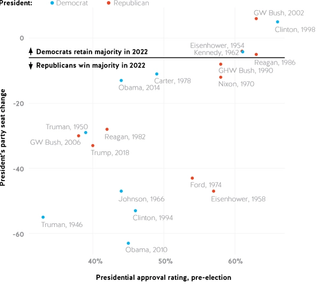
Expectations Republicans will win control of the House in the November 2022 midterm elections have loomed large over the Biden presidency since it began and will continue to do so. With Democratic senators Manchin and Sinema all but certain to oppose most of the Biden legislative agenda, any appetite Democratic House moderates might have had for boldness has largely evaporated. Indeed, Democratic boldness might only come from the “swan song” votes of a record number of retiring Democrats. The balance of the 117th Congress is then likely to be consumed by ’position-taking,’ with legislators in safe seats shoring up their position in their parties’ primaries, and Democrats using their control of the congressional agenda to find votes that put Republicans representing moderate seats in politically awkward positions. Little substantive legislating can be expected to result.
This erosion of Biden’s popularity all but ensures Republicans will win back the US House of Representatives in the November 2022 midterms.
Hovering over all of these developments is former President Trump and the spectre of his leadership, or inspiration, of yet more democratic backsliding in the United States (see more below).
Remarkably, despite Republican losses in the 2018 midterms, the 2020 presidential election, and the 2020 Senate and House elections, Trump’s hold over the Republican party appears mostly undiminished. The “Big Lie” that the 2020 election was stolen from Trump has, correspondingly, become an article of faith for Republicans. Perhaps more remarkably, only the bravest or most secure Republicans dare critically examine the January 6, 2021 Capitol riot and its attempted subversion of the 2020 election result. One recent indication of Trump’s hold was the Republican National Committee censuring the Republicans participating in the congressional investigation into the Capitol riot, despite many Republicans condemning those events at the time.8
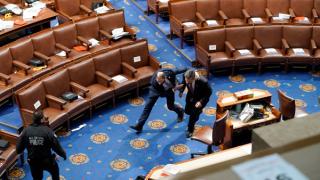
In turn, the “Big Lie” has become the rationale for an accelerated Republican-led campaign of legalised voter suppression across several US states, involving the consolidation of election administration powers in Republican-controlled state legislatures, and partisan gerrymandering.
Meticulous research by New York University’s Brennan Center for Justice finds that 2021 saw far and away the most state legislative activity aimed at restricting voting access in the 11 years since they have been tracking these statutes. Indeed, a third of all the restrictive voting laws seen since 2010 were passed in 2021. According to the Brennan Centre, in 2021:
at least 19 states9 passed 34 restrictive laws…[that]… make it more difficult for voters to cast mail ballots that count, make in-person voting more difficult by reducing polling place hours and locations, increase voter purges or the risk of faulty voter purges, and criminalize the ordinary, lawful behavior of election officials and other individuals involved in elections.10
The following analysis traces the form, extent and sources of democratic backsliding in recent years in the United States, drawing on original survey research and analysis by the United States Studies Centre. In turn, it documents historically high levels of isolationism, a profound lack of optimism about the future of the United States, and deep partisan disagreements about what problems the United States faces — at home and abroad — and how to address them.
Quite simply, the United States is less democratic than Australia, perhaps not by much in decades past, but unmistakably so now.
It is commonplace to identify “shared democratic values” as the rationale for Australia’s close relationship with the United States. But, the analysis presented here leads to a more confronting, harder truth. Quite simply, the United States is less democratic than Australia, perhaps not by much in decades past, but unmistakably so now. Moreover, the United States remains prone to democratic backsliding at best, if not a deep erosion of liberal democracy.
Australia can and should put our democratic values at the heart of strategic policy. But Australia may well face a future in which the gap between reality and rhetoric about the alliance cannot be ignored. An honest appraisal of Australia’s interests in its deep and broad relationship with the United States now would be vital insurance for a future in which many Australians might rightly look askance at a United States they simply do not recognise as a healthy, flourishing liberal democracy.
Democratic backsliding in America
by Professor Simon Jackman
Over the course of the Trump presidency, analysis and commentary on democratic backsliding and authoritarian resurgence grew from a trickle to a flood. Turkey, Hungary, Poland, Brazil and India were the initial focus of this analysis, where the election of autocratic, “strong man” political leaders presaged an erosion of liberal democracy.
The United States joined this list of countries with diminishing levels of liberal democracy, as assessed by the internationally respected Varieties of Democracy (VDEM) project and shown in Figure 1.4.11 After falling to a global rank of 26th in 2001, the United States rebounded over the balance of the George W. Bush presidency, reaching a rank of fifth in 2007, the highest-ranking on liberal democracy ever obtained by the United States. The United States had fallen three places to eighth by the last year of the Obama presidency. But such a drop pales in comparison to the dramatic fall to 29th in the first year of the Trump presidency and a new low of 32nd in 2019.
Figure 1.4. The United States joins a list of countries where liberal democracy is in retreat
Varieties of Democracy Index, 1970-2020

Australia’s trajectory with respect to the VDEM liberal democracy index provides a vivid point of comparison. From Federation to 2006, Australia ranked as one of the world’s 10 highest-scoring countries on this metric. From 2016-2020, Australia’s median rank was 12th, compared to its 1901-2016 median rank of sixth. However, this fall is much less than that observed for the United States, which fell to a median rank of 30th since 2016.
In falling 25 places between 2014 and 2019, the United States joins a small set of countries in the 21st century to be or have been in the top 50 on this measure of liberal democracy and fall 25 places in a five-year span, thereby joining Poland, Hungary and Brazil.
Democratic backsliding, as assessed by expert ratings, measures democratic performance, typically, the actions of political elites, judiciary and the executive government of the day. Mass sentiment and support for democracy is a separate question.
USSC survey research reveals that despite the erosion of liberal democracy in the United States under the Trump presidency, ordinary Americans remain highly supportive of democracy as a system of government. On the other hand, evaluations about democratic performance are far more elastic, driven by partisan evaluations of incumbent leaders and parties.
In USSC surveys since 2019, survey respondents in both the United States and Australia were asked to evaluate the conduct and performance of democracy with the question:
On the whole, are you very satisfied, fairly satisfied, not very satisfied or not at all satisfied with the way democracy works in [America | Australia]?
Over four separate surveys spanning July 2019 to December 2021, the US level of satisfaction with democracy hovers around 50 per cent (see Figure 1.5). Australians consistently report higher levels of satisfaction with democracy than Americans. Furthermore, Australians’ satisfaction with democracy across all partisan groups increased over the COVID-19 pandemic — from 60 per cent in July 2019 to almost 80 per cent in February 2021.
Figure 1.5. Americans are significantly less satisfied with democracy than Australians
Only half of Americans are satisfied with their democracy while four out of five Australians satisfied with theirs. Percentages reporting being “very” or “fairly” satisfied with democracy in their respective country, USSC surveys 2019, 2020 and 2021.
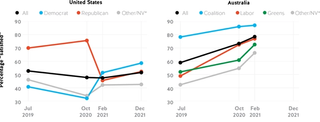
“Satisfaction with democracy” is strongly driven by partisanship. Supporters of the party in government report higher levels of satisfaction than partisans of the “out-party” in both countries. In the opening weeks of the Biden presidency, less than 50 per cent of Trump voters reported being satisfied with democracy in the United States, while Biden voters rebounded from 30 per cent before the 2020 election to more than 50 per cent after it and then 60 per cent in December 2021.
Asking respondents about their level of “satisfaction with how democracy is working” seems to elicit evaluations of the performance of the incumbent government more than a reflection on the performance of democratic institutions and procedures. It is seemingly akin to asking about presidential or prime ministerial approval. Note too, that in both countries and in each survey, respondents not voting or not supporting a major party or candidate consistently report lower levels of satisfaction with democracy — presumably both a cause and a consequence of being disinterested in politics and/or not supporting mainstream parties and candidates.
To better assess levels of support for democracy as a system of government we asked respondents if “having a democratic political system” was “very good, fairly good, fairly bad or very bad” for their respective country. Results from multiple USSC surveys are shown in Figure 1.6.
Figure 1.6. On average, US and Australian evaluations of democracy are similar, but this hides a concerning partisan divide in the United States
Percentages of respondents saying that a democratic system of government is either “very” or “fairly” good, by country and party, USSC surveys 2019, 2020 and 2021
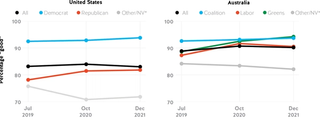
Support for democracy as a political system is high and stable in the United States, with just above 80 per cent evaluating a democratic system of government as “very” or “fairly” good. Unlike evaluations of satisfaction with how democracy is working in the United States, partisan differences in evaluations of democracy as a system are smaller and more stable. Democratic voters are about 15 percentage points more likely than Republican voters to give a positive assessment of democracy as a system of government, irrespective of whether Trump or Biden is president.
Australians are slightly more supportive of democracy as a system of government than Americans, with a 90 per cent rate of positive assessments versus 83 per cent in the US data. There is no statistically significant variation between Coalition, Labor and Green supporters in evaluations of democracy as a system of government, with never more than five percentage points separating partisan groups (right panel, Figure 1.6).
The Australian data provides an important counterpoint to the situation in the United States. In the aggregate, support for democracy as a system of government sits just above 80 per cent in the United States. But like so much in contemporary US public opinion, it is concerning that views about such a fundamental tenet varies across parties in a stable and reliable way and by as much as 10 to 15 percentage points. Both well before the 2020 election and well after, two out of 10 Trump voters reported democracy as being “fairly” or “very” bad as a system of government. Anti-democratic sentiment reaching even this moderate level among the supporters of one of the major parties of the United States — the putative leader of the democratic world — is tremendously significant for democratic allies of the United States, given that shared democratic values figure so prominently in arguments for these alliances.
America’s illiberal turn?
by Professor Simon Jackman
Authoritarianism and populism are frequently invoked in describing what has been happening in American politics and society in recent years. But what are these phenomena? Why do they matter? And how can we measure their prevalence?
Authoritarianism manifests at both micro and macro levels: as a psychological attribute of individuals evidenced through measurements of relevant personality traits and attitudes; and as a property of a political system. At the micro-level, authoritarianism is constant and pervasive, with individuals more or less predisposed to authoritarianism in the same way that human beings differ with respect to other personality traits (like openness to experience, conscientiousness, extraversion, etc). The more relevant question is how authoritarianism might become a feature of a nation’s politics, a question that has been studied almost continuously since the rise of totalitarianism in Europe ahead of the Second World War.12
The more relevant question is how authoritarianism might become a feature of a nation’s politics, a question that has been studied almost continuously since the rise of totalitarianism in Europe ahead of the Second World War.
Most accounts centre on whether political entrepreneurs are activating authoritarianism; in other words, building coalitions by appealing to individuals with authoritarian predispositions. This task may be easier if the polity is facing a threat or crisis where citizens are anxious and insecure and, as such, primed to receive authoritarian appeals. In addition, are political institutions porous, with low entry costs into the political marketplace, encouraging political entrepreneurs? Or does gate-keeping power and incumbency advantage vest in established political parties through electoral law and nominating procedures, in the media environment and in constitutional arrangements? Our assessment is that the US political system is far more porous than Westminster systems, or Canberra’s “Washminster” model.13
Populism is distinct from authoritarianism. It is a political ideology rather than a personality trait; rooted in the belief that political legitimacy derives from giving voice to “the will of the people” (or volonté générale, in Rousseau’s famous formulation). Central to populist narratives is opposition to an elite that purports to act in the national interest while corruptly enriching themselves, their patrons and clients (for example big business, intellectuals, foreigners, immigrants, racial and ethnic minorities).14 The elite at the centre of populist critiques is often portrayed as pervading mainstream political parties and other institutions like the media, rather than concentrated on any one side of a conventional left-right ideological continuum.
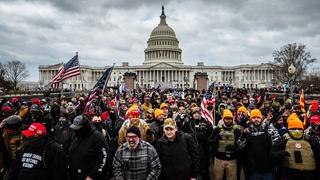
We investigated the prevalence and salience of authoritarianism and populism in US politics in our December 2021 survey. We measured authoritarianism with six items on characteristics deemed desirable in children, long-established as valid and reliable indicators of authoritarianism; and six items measuring components of authoritarianism, such as submission to authority, traditionalism and conventionalism.15 To measure populism we asked about attitudes toward political representation, perceptions of elites versus ordinary citizens, and willingness to compromise. These 18 items and a summary result for each country are shown in Table A2 of the appendix. Comparisons with Australian public opinion again provide a vivid counterpart.
We combine responses to the 12 items tapping authoritarianism and the six items tapping populism into two scales.16 Each scale is constructed such that zero is the mean score across both countries, with positive scores for respondents with more or populist attitudes and conversely for negative scores.
In short, authoritarianism tends to follow party affiliation across the political spectrum in both countries, but more strongly in the United States than in Australia. This is largely driven by the high levels of authoritarianism in Trump voters.
Overall, Americans score a little higher on authoritarianism than Australians, but these aggregate, cross-country differences are overwhelmed by the variation within each country (see Figures 1.7 and 1.8). As reported in appendix Table A3, the average difference between the United States and Australia is just 0.11 units, with the difference between Trump and Biden voters more than 10 times larger (1.18 units). Moreover, the probability that an American chosen at random has a higher level of authoritarianism than a randomly selected Australian is barely better than a coin flip, at 54 per cent; in contrast, a randomly chosen Trump voter has an 80 per cent chance of being more than a randomly chosen Biden voter.
Figure 1.7. Americans barely differ from Australians in levels of authoritarianism, but the US connection between political preference and authoritarianism is stronger
Distribution of authoritarianism by country and political support, formed by analysis of USSC surveys December 2021. In the US data, respondents are grouped by recalled vote in the 2020 presidential election; in the Australian data, by recalled 2019 House of Representatives vote. Details on scale construction appear in the methodological appendix.
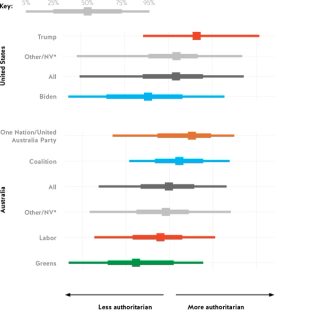
Figure 1.8. Populism abounds in both countries, but Trump voters stand apart
Distribution of populism by country and political support, formed by analysis of USSC surveys December 2021. In the US data, respondents are grouped by recalled vote in the 2020 presidential election; in the Australian data, by recalled 2019 House of Representatives vote. Details on scale construction appear in the methodological appendix.
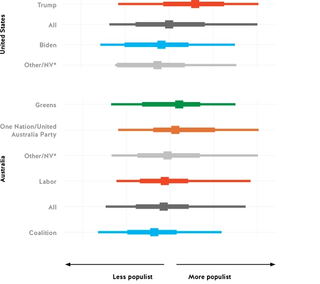
In Australia, only One Nation and United Australia Party voters come close to recording the same levels of authoritarianism typical of Trump voters. Trump voters are more authoritarian than Coalition voters by almost the difference between Coalition voters and Labor voters. In contrast, Labor voters appear slightly more authoritarian than Biden voters — and Green voters slightly less authoritarian — such that the distribution of authoritarianism over the combination of Labor and Green voters is extremely similar to that of Biden voters.
Every society has its authoritarians and it is not noteworthy that the United States has a significant proportion of its citizens exhibiting high levels of authoritarianism. So too does Australia. What is distinctive is that so many voters with authoritarian dispositions have parked their political loyalties with one of the United States’ major political parties, at least under Donald Trump. Conservative politics in Australia hasn’t been so captured, nor has it sought to capture the votes of authoritarians in the same way as the Republican party.
Trump voters also score high on populism (see Figure 1.8), with an average score of 0.56 standard deviations units above the overall mean score of zero; Biden voters have an average populism score of -0.17, with 0.73 standard deviation units separating the two voting blocs in the United States.
Overall, Australians display slightly lower levels of populism than Americans, but just as with authoritarianism, this cross-country variation is small relative to the within-country variation. Distinguishing between Americans and Australians in terms of the proportion of populists is barely more accurate than a coin flip: as reported in Table A4 in the appendix, the probability that an American chosen at random is more populist than an Australian chosen at random is just 54 per cent.17
However, comparing the concentration of populists among Trump voters contrasts starkly with what we observe in Australia. Between Coalition and Labor voters — supporters of Australia’s two parties of government — the difference in mean populism scores is just 0.29 units, or less than half the difference between Trump and Biden voters.
Populism in Australia concentrates among the supporters of smaller, non-governing parties: the Greens, One Nation and the United Australia Party. Supporters of the incumbent party of Australia’s national government, the Liberal-National Coalition, record the lowest average levels across both countries, so much so that populism does a very good job of distinguishing Coalition voters from Trump voters: the probability that a randomly chosen Trump voter is more populist than a randomly chosen Coalition voter is 75 per cent.
Some of the anti-establishment, populist sentiment reported by Trump voters is no doubt transitory, a reflection of the fact that Republicans have majorities neither in the House of Representatives nor the Senate and a Democrat is president. But these data also reveal a remarkable facet of contemporary US politics: that under Trump — and even after Trump was defeated in 2020 — the Republican Party’s supporters are disproportionately authoritarian and populist. Unlike Australian politics — where high levels of authoritarianism and populism are concentrated in the supporters of parties that do not form governments — authoritarianism and populism lie at the heart of mainstream US politics, shaping and structuring electoral competition and political discourse.
This illiberal turn in US politics has direct implications for Australian national interests, which we elaborate on in the following pages. Related to the currency, salience and concentration of authoritarianism and populism among Republican voters are historically high levels of isolationism, a profound lack of optimism about the future of the United States, and deep partisan disagreements as to what problems the country faces — at home and abroad — and how to address them.
The normalisation and mitigation of conspiracy
Long before QAnon or Pizzagate, conspiracy was enmeshed in American culture from its earliest days. Newly independent Americans were virulently anti-Masonic. The 19th-century Protestant majority was strongly anti-Catholic. After the Second World War, US senators and conspiracy theorists alike claimed godless Communists hid under beds and in the highest echelons of US institutions.18
The paranoid style of each movement is expressed through conspiracy theories. These theories most commonly hold that bad foreign actors are plotting to take down the United States and its experiment in democracy. Yet in addition to conspiracy, two newer catchwords have emerged in the age of social media, President Donald Trump and COVID-19: misinformation and disinformation. While often mistakenly used synonymously, these phenomena are distinct.
Misinformation “constitutes a claim that contradicts or distorts common understandings of verifiable facts.”19 By definition, misinformation is false. This falseness, however, is politically and ethically neutral; after all, ignorance and misunderstandings are normal features of our social lives. Claims hydroxychloroquine could treat COVID-19 were unsubstantiated, but like most misinformation about COVID treatments, were shared in an effort to try and help others.
Disinformation, on the other hand, is misinformation deployed to deliberately deceive and destabilise. When foreigners pretended to be Americans and ran online campaigns to shift votes in the 2016 election, they knowingly shared misinformation to achieve a certain outcome.
Conspiracy occupies shakier, less defined ground that, in turn, affects the foundations on which judgements are made about misinformation and disinformation. It is the assigning of intent in terms of a worldview that drives and spreads beliefs.
Conspiracy fuels both sides of US politics. The Russiagate assertions that Trump was a Manchurian candidate are as ridiculous or reasonable as claims that the 2020 election was stolen from Donald Trump. The dangers of partisan institutions touting conspiracy for political gain are evidenced by the January 6 Capitol riot.20

Complicating this challenge is the fact that traditional sources of knowledge and truth are fallible and fungible. Media outlets focus on topics, people and emphases that increase viewership; the US Supreme Court comprises partisan picks that set the parameters of US social and material life; rules and reasons around COVID-19 prevention change continually.
When this fungibility is combined with the intense affordances of online communication — where, for example, a very small number of often non-human accounts drive a disproportionate volume of misinformation21 — conspiracy becomes an almost necessary means by which to make sense of the world.
Merely dismissing citizens’ claims about the world as conspiracy has little positive effect because this kind of theorising is also undertaken by institutions and governments, which further destabilises the foundations on which any claims are made.
One increasingly bipartisan belief among members of Congress is that better regulation of speech on the internet could mitigate the dangers of misinformation, disinformation and conspiracy — most notably through amending Section 230 of the US Communications Decency Act. While this may constrain some extremes, conspiracy is ultimately an elemental feature of American life. Radical transparency in motive and action, as well as recognising the conspiratorial features of political communication, might be the only means by which institutional actors can responsibly navigate this challenging terrain.
America’s domestic policy priorities
by Professor Simon Jackman
Key issues for US allies are the US public’s appetite for bearing the costs of global leadership, the priority given to foreign policy and security challenges relative to domestic issues and, more broadly, America’s self-confidence and sense of purpose.
In USSC’s December 2021 survey, we asked Americans and Australians to choose their three most important issues from a list of 10. A summary of responses appears in Figure 1.9.
Figure 1.9. Americans can barely agree as to what are America’s most pressing problems, unlike Australia
Rates of listing a given policy issue as one of the country’s top-three problems, by country and party, United States and Australia, USSC surveys December 2021
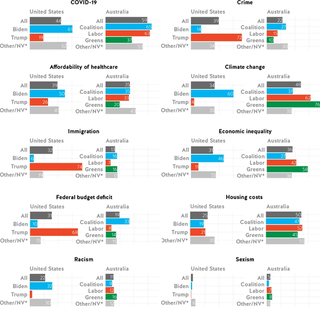
COVID-19 is the primary concern, consistently selected as one of the United States’ top-three most important problems (MIPs), with 44 per cent of all respondents rating the pandemic in their top three. Thirty-nine per cent of Americans rate both crime and the affordability of healthcare among their top-three MIPs, followed by climate change (34 per cent) and immigration (32 per cent).
While COVID-19 is also the issue most frequently identified by Australians as a top-three issue (59 per cent), housing costs (50 per cent) and climate change (48 per cent), followed by economic inequality (36 per cent) and healthcare affordability (35 per cent), show a markedly different ordering of priorities than that seen for Americans. Crime is nominated as a top-three MIP by only 22 per cent of Australians, while just 25 per cent of Americans list the cost of housing as a top-three MIP. Twenty-two per cent of Americans nominate racism as a top-three MIP, but only 11 per cent of Australians.

We also observe considerable dispersion in the rates at which Americans select issues as MIPs. The top-three issues in the United States (COVID-19, crime and healthcare affordability) are nominated by 44 per cent, 39 per cent and 39 per cent of respondents. But the top-three MIPs selected by Australians (COVID, housing costs and climate) were selected by 59 per cent, 50 per cent and 48 per cent, indicating much more consensus in Australia about the country’s pressing issues than the United States.
Looking more closely at Figure 1.9, note the large cross-party differences in assessments of issue salience for the United States, with Biden voters’ MIPs being COVID-19 (61 per cent), climate change (60 per cent) and healthcare affordability (50 per cent), contrasted with Trump voters’ prioritisation of immigration (74 per cent), crime (72 per cent) and the budget deficit (68 per cent).
Table 1 further explores these cross-party differences in assessments of issue salience in both countries.
Table 1. Defining the country’s top problems: US and Australian political polarisation quantified
Differences across party lines on issue importance, by country. Table entries show percentages of each group of voters rating an issue as one of their top-three most important issues; |∆| is the magnitude of the difference of the ratings for each issue, between the two groups of voters in each country. Respondents are grouped by recalled vote in the 2020 US presidential election or the 2019 Australian House of Representatives election. The higher the |∆| number, the greater the magnitude of difference; the smaller the |∆| number, the more there is agreement between voters.
|
|
United States |
|
Australia |
||||
|
Issue |
Trump |
Biden |
|Δ| |
|
Coalition |
Labor |
|Δ| |
|
Immigration |
74 |
6 |
69 |
|
16 |
7 |
9 |
|
Crime |
72 |
14 |
58 |
|
27 |
15 |
12 |
|
Federal budget deficit |
68 |
10 |
58 |
|
33 |
8 |
25 |
|
Climate change |
4 |
60 |
56 |
|
37 |
62 |
25 |
|
COVID-19 |
19 |
61 |
41 |
|
65 |
63 |
2 |
|
Economic inequality |
11 |
46 |
36 |
|
27 |
42 |
15 |
|
Racism |
3 |
32 |
29 |
|
9 |
12 |
3 |
|
Affordability of healthcare |
26 |
50 |
24 |
|
35 |
33 |
1 |
|
Housing costs |
21 |
19 |
2 |
|
47 |
52 |
4 |
|
Sexism |
0 |
2 |
1 |
|
3 |
7 |
3 |
Take the case of COVID-19, the issue most frequently assessed as a top-three MIP in both countries. In the United States, 61 per cent of Biden voters rate this as a top-three MIP, but only 19 per cent of Trump voters agree. Contrast Australia, where 65 per cent of Coalition voters and an almost identical 63 per cent of Labor voters rate COVID-19 in their top three. Trump voters’ most frequently nominated issue, immigration (74 per cent), is ranked ninth out of 10 by Biden voters, with just six per cent of Biden voters placing immigration in their top three.
Americans are so polarised today that they disagree profoundly as to what are the nation’s most important problems, let alone what to do about those problems.
Climate change is rated as a top-three MIP by 61 per cent of Biden voters, making it the second-most salient issue for Biden voters; but only four per cent of Trump voters rate climate change a top-three MIP, ending up eighth out of the 10 for Trump voters. Climate change is one of the more polarising issues in Australian politics, but even in this case climate is the second-most salient issue for Labor voters (62 per cent rating it as top-three MIP) and the third-most salient for Coalition voters (37 per cent), the 25-point difference in salience ratings is the largest in the Australian data.
The high degree of cross-party consensus in issue salience in Australia is reassuring to a degree: supporters of Australia’s two major parties may disagree over policy, but there is, at least, consensus as to the challenges Australia faces. By contrast, the only things that Americans seem to agree on are that sexism is not an important problem and that housing costs are marginally important.
A bleak conclusion follows: Americans are so polarised today that they disagree profoundly as to what are the nation’s most important problems, let alone what to do about those problems.
America in the world
by Professor Simon Jackman
America’s foreign policy priorities
Repeating a question fielded in USSC’s February 2021 survey, we asked Americans to rate the importance of three different foreign policy priorities in our December 2021 survey. We asked Australians an identical question about Australian foreign policy priorities as well.
As shown in Figure 1.10, there is little change in the results between February and December 2021, save for a small increase in the importance accorded to “dealing with climate change” in the Australian data. Democracy promotion and “working with allies to stand up to China” fell in importance in both countries.
Figure 1.10. Polarisation in the United States extends to foreign policy priorities
Biden voters look similar to Australian Labor voters, but Trump voters stand apart from Coalition voters. Foreign policy priorities, by vote and country, USSC surveys February 2021 and December 2021. Respondents were asked to rate each foreign policy goal; the percentages plotted are the proportion of each group ranking the particular issue as their most important foreign policy goal or equally most important goal.

In aggregate, both climate change and the China-focused goal command the ‘highest importance’ assessments in both countries; climate change beats out “working with allies to stand up to China” in the Australian data, with 71 per cent giving climate change the top or equal top billing, versus 61 per cent for the China-focused item.22 In the United States, climate change and the “allies…China” goal are rated top or equal top by indistinguishable proportions, 64 per cent and 65 per cent, respectively.
The “Indo-Pacific” does not resonate for Americans
The “Indo-Pacific” is now firmly entrenched in the argot of strategic affairs, a successful case study in the way that the deft exercise of strategic imagination can give rise to strategic constructs and, in turn, changes in policy and facts “on-the-ground.” Unsurprisingly and unquestionably, the Indo-Pacific is the focus of Australian strategic policy. But how does the “Indo-Pacific” fare as a regional priority for ordinary Americans? In particular, from an Australian perspective, is it a helpful formulation to steer US strategic and public focus towards the region?
To assess this, USSC deployed a question-wording experiment, in which US survey respondents were asked “Which of the following regions should be the highest priority of the US Government?”
Five options were provided: Europe, the Middle East, Africa, Latin America and a random selection of either “Asia-Pacific” or “Indo-Pacific,” with the order of the five options also randomised. Responses are shown in Figure 1.11:
- Europe is the most popular choice for Americans irrespective of whether it is competing with “Asia-Pacific” or “Indo-Pacific.”
- The term “Indo-Pacific” appears to suffer from perhaps being unfamiliar to Americans, leading to a nine-point fall in the rate at which respondents nominate the region as their preferred “highest priority,” 17 per cent versus 26 per cent for “Asia Pacific.”
- While the “Asia-Pacific” (26 per cent) is virtually indistinguishable from Europe (27 per cent) and beats the Middle East (22 per cent) as a regional priority for the United States, the “Indo-Pacific” falls back to equal third with Latin America (17 per cent), far behind the Middle East on 28 per cent.
- Trump voters appear to be the most sensitive to the difference between “Indo-Pacific” and “Asia-Pacific.” “Asia-Pacific” is selected by 33 per cent of Trump voters, ahead of Europe (26 per cent) and the Middle East (24 per cent). Switching to the “Indo-Pacific” sees the region selected by only 20 per cent of Trump voters, far behind Europe (37 per cent) and the Middle East (32 per cent).
- Biden voters clearly see Europe as the most important regional focus for the United States, selected by 33 per cent (the same proportion of Trump voters that select “Asia-Pacific”), a position unchanged by whether Europe is competing with “Asia-Pacific” or “Indo-Pacific.”
Figure 1.11. Americans do not rate the Indo-Pacific as the priority region
Europe and the Middle East deemed more important while more preferred “Asia-Pacific” over “Indo-Pacific.” Respondents were asked to select one of five possible options in response to the question “Which of the following regions should be the highest priority of the US government?” Respondents were randomly allocated to one of two different versions of this question, one using the term “Indo-Pacific,” the other using “Asia-Pacific.” Results show the pattern of responses by the form of the question and by the 2020 presidential vote; USSC survey December 2021.
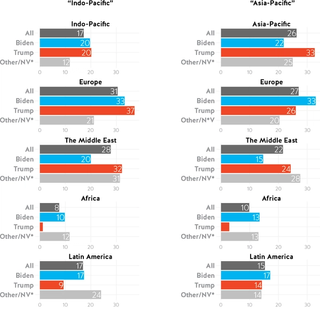
In the battle for hearts, minds and US strategic focus, words matter. Notwithstanding the success of embedding the “Indo-Pacific” in the world’s strategic vernacular, the term does not resonate with the US public, nor with Trump voters in particular.
On the contrary, the use of “Indo-Pacific” does nothing to draw the focus of Biden voters away from Europe; and drives Trump voters towards Europe, making Europe the single most popular choice of both Biden and Trump voters (33 per cent and 37 per cent, respectively).
Presumably, creating partisan consensus around Europe as the most important regional focus for the United States was not what thought leaders in the Australian strategic affairs community had in mind when popularising the term “Indo-Pacific.”
Presumably, creating partisan consensus around Europe as the most important regional focus for the United States was not what thought leaders in the Australian strategic affairs community had in mind when popularising the term “Indo-Pacific.”
Accordingly, it may be a case of carefully choosing the form of words being used when in dialogue with American counterparts: “Asia-Pacific” in public fora, and “Indo-Pacific” when in consultation with strategic affairs specialists.
Defence spending
Further, partisan disagreement is apparent when we turn to a critical policy variable: the size of the US defence budget. We asked survey respondents if the United States should “spend more” on defence, “spend less” or “maintain spending at current levels.” To assess the effect of different “frames” or “primes,” one version of the question references the current proportion of US Government spending directed towards defence; another version references the level of China’s defence spending relative to that of the United States; a “baseline” or “control” version of the item. Results are shown in Figure 1.12; the lower panel of the figure shows the difference between the “spend more” response and the “spend less” response, a measure of the strength of preference for increased or decreased defence spending.
Figure 1.12. Trump and Biden voters are almost diametrically opposed on defence spending, leaving no overall preference for increasing or decreasing defence spending
Quantifying US polarisation in defence spending shows little room for compromise. Respondents were asked if the US should “spend more”/“spend less” or “maintain spending at current levels” on defence, after being randomly assigned to one of three conditions: (1) a baseline/control condition with no additional text; (2) the question is preceded with the sentence “Currently, one out of every $10 spent by the US Government each year goes to defense” or (3) with a proceeding sentence which reads “Over the past 10 years, China’s annual defense spending has increased by 76 per cent to $250 billion. Over the same period, US annual defense spending has decreased by 10 per cent to $760 billion.” Responses grouped by 2020 presidential vote; USSC survey December 2021. The lower panel shows the difference between the percentages of those wanting more defence spending and those wanting less defence spending, by group. Positive/negative quantities imply a net preference for more/less defence spending within the group.
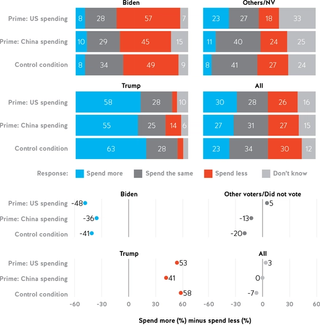
We see a familiar pattern in these data. Overall, there is very little appetite for increased defence spending, the result of strong preferences for decreased spending among Biden supporters, and, perhaps, slightly stronger preferences for increased defence spending among the slightly smaller group of Trump supporters. These differences across partisan lines are large and persistent and swamp the magnitude of any differences due to framing effects.
In aggregate, either of the two substantive priming conditions generates slightly more support for increased defence spending than the baseline, “vanilla” version of the question, where “spend more” trails “spend less” by seven percentage points. This margin drops to zero under the “China comparison” frame and is +3 in favour of “spend more” under the “US” frame.
The effects of the different frames or primes work inconsistently across partisan groups. Biden voters record their highest levels of “decrease” responses under the frame that reminds voters that defence accounts for about 10 per cent of US Government spending. Meanwhile, the “increase” response is seen least frequently among Trump voters under the frame that compares the United States and China, while this same frame seems to slightly tamp down Biden voters’ opposition to increased defence spending.
Partisan polarisation and the limits of American power
The most striking feature of these results is the large and persistent differences across party lines in the US data. Virtually every Biden voter in the survey rates “dealing with climate change” as the nation’s most important (or equally most important) foreign policy goal; less than one in five Trump voters are of the same view. Conversely, 92 per cent of Trump voters rate “working with allies to stand up to China” as their most important foreign policy goal, but just 48 per cent of Biden voters share this assessment.
There is more partisan agreement in the United States on the importance of allies standing up to China than on climate change as foreign policy priorities. But again, the contrast with the Australian data is revealing. Supporters of the conservative side of politics in both countries are more likely to prioritise standing up to China than climate change, while the converse holds for supporters of the centre-left parties. But even the largest partisan splits in Australia are small relative to those in the United States.
We assess that the Biden administration is probably slightly ahead of its supporters in its prioritisation of “working with allies to stand up to China” and defence spending, while probably lagging its supporters with respect to “dealing with climate change” as foreign policy goals.
Two conclusions follow. First, there is not a deep reservoir of political capital in the Democratic base for a tougher China policy; climate change animates the Democratic base much more than “working with allies to stand up to China.” Australian political leaders and policymakers ought to be sensitive to this fact: while there is a “policy establishment” consensus in Washington on the importance of China, this does not hold in the mass electorate. Perhaps ironically, the prospect of Republicans taking control of at least the House of Representatives over the second half of the Biden term will see fewer political headwinds in terms of defence spending and China policy from Congress, at the cost of deep deadlock on climate policy.
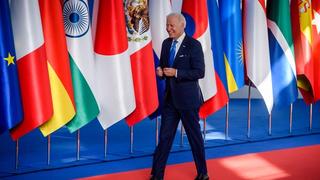
Isolationism
Any possible consensus on US foreign policy priorities must contend with other bleak data points revealed by our survey.
First, isolationism remains at historically high levels in the United States, with 40 per cent of Americans agreeing that “this country would be better off if we just stayed at home and didn’t concern ourselves with others’ problems” (see Figure 1.13). For decades, public opinion researchers used rates of agreement with this proposition as a measure of isolationism. Prior to 2016, the American National Election Studies never found more than 30 per cent of Americans to hold isolationist beliefs in a time series dating back to 1952, with levels of isolationism usually in the mid-20s.
Figure 1.13. US isolationism is at historically high levels, but remains a minority view
Percentages agreeing that “this country would be better off if we just stayed at home and didn’t concern ourselves with others’ problems,” by 2016 and 2020 presidential vote, USSC surveys July 2019 to December 2021.

It is also historically unusual for Republicans to be more isolationist than Democrats. But under Trump’s leadership, this long-standing regularity of US politics has been inverted. Well before Trump’s election loss in 2020, Trump supporters were already more than 10 percentage points more isolationist than Democrats. But note that all groups in the United States grew more isolationist between the July 2019 and October 2020 surveys. Immediately after Trump’s election loss in 2020, an unprecedented 60 per cent of Trump voters reported isolationist beliefs, moderating to about 45 per cent in USSC’s most recent December 2021 survey.
All political groups in the United States are growing more isolationist to levels seldom seen, if ever, in decades of public opinion research.
But at the same time — and with a Democrat as president — Biden voters have continued to trend in an isolationist direction, with more than 30 per cent reporting isolationist beliefs. The movement by Trump voters towards isolationism is a big part of the story. But all political groups in the United States are growing more isolationist to levels seldom seen, if ever, in decades of public opinion research.
Pessimism about America’s future
Second, Americans have higher levels of pessimism about their country than we have seen in previous surveys. We measure this with a simple question asked on all of our surveys: “Are America’s best days in the future or have been in the past?” Figure 1.14 charts responses to this question over four USSC surveys, in both the United States and Australia.
Figure 1.14. Pessimism about the United States’ future is rising, even among Biden’s supporters
Percentages responding that America’s “best days are in the past,” by country and vote, USSC surveys 2019, 2020 and 2021

In USSC’s December 2021 survey, the proportion of Americans reporting that “America’s best days are in the past” rose to 60 per cent, comfortably more than a majority viewpoint, and an increase of about 15 percentage points, or a third, from July 2019. Again, this rise is not just a sour grapes response on the part of Trump voters, with 75 per cent of them giving the “best days in the past” response. Democrats have become more pessimistic even while they have a Democratic president, with almost 50 per cent providing the “in the past” response, their pessimism rising to levels they were reporting when Trump was president in USSC’s 2019 and 2020 surveys.
Optimism about the future of the United States is a minority viewpoint in Australia and across all voting groups, which largely tracks sentiment towards the United States more broadly. Coalition supporters are generally the least pessimistic about the future of the United States, followed by Labor and then the Greens. As has been the case in all our surveys, about 70 per cent of Australians say the United States’ best days “were in the past” — far more dour on prospects for the United States than Americans themselves.
Attitudes towards alliances and AUKUS
by Jared Mondschein and Professor Simon Jackman
Australia has had a formal security alliance with the United States since 1951. Australia has also fought alongside the United States in every major conflict since the Second World War. Little wonder then that Australia is consistently highly regarded as an ally within the United States. In the age of strategic competition, the US-Australia alliance is foremost among the US political and foreign policy establishment. But after enjoying preeminent status with a Trump administration not overly fond of most US alliances — and receiving one of the administration’s two State visits — has the perception of Australia been tarnished by US polarisation? How do ordinary Americans view the relationship between Australia and the United States?
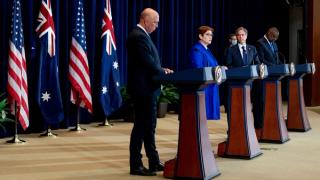
US respondents in both countries were asked to assess whether they saw other countries as an “ally” of their country, as “friendly” towards their country, as “unfriendly” towards their country, or as an “enemy” of their country (see Figure 1.15). About 53 per cent of Americans responded that Australia is an ally of the United States, a rate exceeded only by the United Kingdom (61 per cent). Australia outperformed other Indo-Pacific allies and partners on this measure, including Canada (51 per cent), New Zealand (34 per cent), Japan (28 per cent) and South Korea (41 per cent).
Figure 1.15. Australia, Canada and the United Kingdom remain the countries most often recognised as US allies
Percentage describing country as an ally of the United States, by 2016 and 2020 presidential vote, USSC surveys 2019, 2020 and 2021
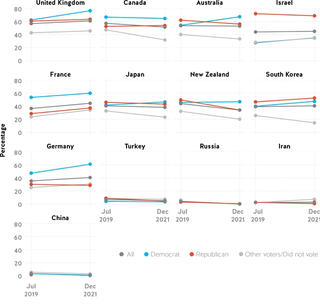
Amid many differences between the Trump and Biden administrations, the role and view of US allies is one of the starkest contrasts. As much as the Trump administration prioritised ‘America First’ in their foreign policy, the Biden administration champions the role of allies, particularly in the age of strategic competition.
Given these different views as to the value of alliances between the Trump and Biden administrations, we asked US respondents whether six specific US alliances made the United States more secure, less secure or neither (see Figure 1.16).
Figure 1.16. Plurality of Americans are unsure if alliances make the country safer or not
"Do the following alliances make the United States more or less secure?” Responses grouped by 2020 presidential vote, USSC survey December 2021

Significantly more Americans said US alliances make the United States more secure than not — no more than 12 per cent of Americans said any of the six alliances made the United States less secure. Yet perhaps most striking is that, except for responses on Japan, the largest group of respondents — around half or more — said the US alliances made the United States neither more nor less secure. It seems that in most instances, the majority of Americans are unsure about the value of US alliances.
In September 2021, the Australian, US and UK governments announced the formation of the AUKUS trilateral security partnership. In addition to collaborating on deeper integration of security and defence-related science, technology, industry and supply chains, the longstanding allies pledged to support the Royal Australian Navy’s acquisition of nuclear-powered submarines.
Without mentioning that the AUKUS agreement had already been announced, USSC asked US respondents whether they agreed or not that the United States should share “technology used in nuclear-powered submarines” with close allies such as Australia and Japan (see Figure 1.17).
Figure 1.17. What’s AUKUS? Slightly more Americans support sharing nuclear-powered submarine technology with Australia than Japan
“The United States should share military technologies with a close ally, such as [Australia/Japan], including the technology used in nuclear-powered submarines.” Responses grouped by 2020 presidential vote; USSC survey December 2021. Respondents were randomly assigned to either the ‘Australia’ or ‘Japan’ version of the question.
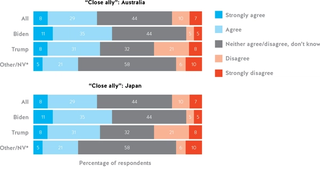
Similar to respondent views on whether specific allies made the United States more secure or not, the plurality of US respondents appeared unsure on this issue. Slightly more Americans supported sharing the technology with Australia (35 per cent) than with Japan (31 per cent) but again, the largest group in both countries either did not know or were unsure.
2024 presidential candidates: US and Australian preferences compared
by Dr Shaun Ratcliff and Sarah Hamilton
One year after the 2020 presidential election, Democratic presidential candidates maintain a small advantage in public support with both American and Australian audiences.
USSC tested presidential vote intentions by providing US respondents with three head-to-head electoral contests that randomly paired one of three potential Republicans versus one of three potential Democratic candidates for the 2024 presidential election. Despite the steadily declining approval rating of Democratic President Joe Biden — now lower at this point in his first term than any other modern president, except Donald Trump — most respondents still preferred the Democratic candidate, regardless of which Republican they faced. However, in most scenarios the margin was small.
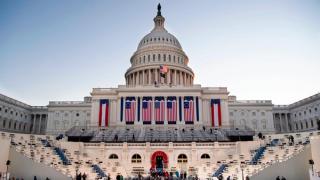
Overall, there is little partisan movement from the November 2020 presidential election. Ninety-nine per cent of respondents who voted for Donald Trump at the 2020 presidential election said they intend to vote Republican in 2024, even if Florida Governor Ron DeSantis or former UN Ambassador Nikki Haley replaced Donald Trump as the candidate. Similarly, almost all (97 per cent) of those who voted for Biden in November 2020 still planned to vote for a Democrat in 2024, even if the head of the ticket was replaced with Kamala Harris or Elizabeth Warren.
Trump remains the preferred candidate for the 2024 presidential election for 95 per cent of Republicans. While the House Select Committee on the January 6 attack continues to close in on Trump’s inner circle, he still appears to be the Republican favourite for 2024. In general, voter sentiment about the Republican Party, and the former president himself, has recovered from prior lows.
Despite President Biden’s falling approval rating and Trump’s post-election sentiment recovery, more American voters still prefer a Democratic presidential candidate, regardless of which Republican they faced.
Our 2024 voting tournament
It is far from certain that either Biden or Trump will be their party’s candidate in 2024, or who may take their place as the top candidate for either party. Therefore, we tested the electoral strength of multiple potential candidates, three Democrats and three Republicans. Each respondent was presented with three random pairings from the set of nine possible Democratic/Republican match-ups, subject to the constraint that each respondent sees all three Democrats and all three Republicans in the match-ups presented to them. The following candidates were selected because they are recognisable to many Americans and are significant representatives of their respective parties:
Potential Republican candidates
- Former president Donald Trump
- Former US Ambassador to the United Nations and Governor of South Carolina Nikki Haley
- Current Governor of Florida Ron DeSantis
Potential Democratic candidates
- President Joe Biden
- Vice President Kamala Harris
- Senator for Massachusetts Elizabeth Warren
Respondents were asked, “If an election for president were being held today, and the following candidates were on the ballot, how would you vote?” A respondent received each candidate once, meaning they received all six over the course of three questions. However, the pairings were random.
The sample size of the two-party vote for these head-to-head match-ups was small (approximately 300). With a sample size of 1,200, and three match-ups presented to each respondent, each of the nine match-ups is shown to about 400 respondents, but each Democratic and each Republican candidate appears in 1,200 match-ups. This design sees us trade-off precision with respect to any particular match-up against unduly burdening our survey respondents, while at the same time giving us considerable statistical power with respect to the electoral strength of each candidate. The respondents were drawn from a representative sample of the United States, rather than filtering only for likely voters. Because voting is not compulsory, sentiment and candidate preference may not translate into actual votes and a significant factor in 2024 will be how well the candidates can draw voters to the polls.
Despite the apparent preference for Democratic candidates, in most scenarios the margin was small. In seven of the nine possible scenarios, the Democratic candidate was estimated to win the two-party popular vote (Figure 1.18). The exceptions to this were Elizabeth Warren versus Donald Trump, and Kamala Harris against Nikki Haley. In both cases, the Republican candidate’s lead was not statistically significant, suggesting caution in inferring too much from these results. In most scenarios, the Democratic lead was also often small and within the margin of error.
Figure 1.18. Nine hypothetical presidential match-ups
Estimated two-party vote with different candidates

However, in four instances the Democratic lead was larger. Three were exceptionally large: Biden versus DeSantis, Harris versus Trump and Warren versus Haley (all with margins of approximately 16 per cent). Biden versus Haley was also large (with an eight per cent gap) and outside the margin of error.
The preference results for Republican candidates are shown in Figure 1.19 and Democrats in Figure 1.20. These include estimated support across the entire sample (the grey bar in each plot) and by vote at the 2020 presidential election. Averaged over the nine match-ups, we find Trump to be unambiguously the best performing Republican candidate, followed by DeSantis and a substantial gap to Haley. Biden and Harris perform equally well over the pairings against the three Republican candidates, well ahead of Warren.
Figure 1.19. Biden still beats out Kamala Harris and Elizabeth Warren for the Democratic vote
Voter intention by 2020 vote if the 2024 Democratic candidate is...

Figure 1.20. Donald Trump and Ron DeSantis top Republican preferences
Voter intention by 2020 vote if the 2024 Republican candidate is...

These results indicate that regardless of the three Republican candidates presented, 99 per cent of 2020 Trump voters say they still plan to vote Republican in 2024. However, there was some variation within that group. Support for Trump and DeSantis was a little higher (47 per cent of the two-party vote) and lower for Haley (44 per cent). This was driven by Trump doing better with ‘Other’ voters (those who voted for third parties or did not vote in 2020) than the other Republican candidates, although Haley did slightly better with Biden voters from 2020. Joe Biden was the strongest Democratic candidate tested in this survey, with an estimated two-party vote of 55 per cent. This was an improvement on candidate Biden’s 2020 election performance, where he held 52 per cent. Support for Harris was nearly as high, at 54 per cent across the three scenarios. Warren had the lowest support of the three Democrats, but still a majority of the two-party vote. As with the Republican candidates, the different levels of support were largely explained by variation from ‘Other’ voters, who were most likely to say they would vote for Biden (although support for Harris was virtually as high) and least likely to say they would vote for Warren. Democratic candidates were fractionally less likely to retain the support of those who voted for Joe Biden in 2020 than their Republican opponents were to keep former Trump voters (although this difference is small, and uncertainty is high).
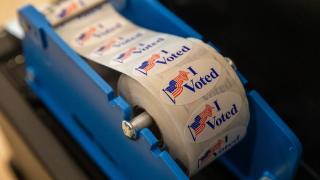
The Australian opinion of US politics
Donald Trump remains politically competitive in the United States but unpopular in Australia, where Joe Biden is the preferred presidential candidate by a wide margin.
Unlike Americans, one year after the presidential election Australians’ preference for Donald Trump dropped from 23 per cent in October 2020 to less than 17 per cent in December 2021. Support for Joe Biden also declined during this period, from 49 to 45 per cent. However, preference for “another candidate” increased, going from 13 to 28 per cent.
Liberal-National Coalition voters, and ‘Others’ (voters who supported The Greens, minor parties and independents, as well as those who did not vote at the 2019 election) were more likely to support Donald Trump than Labor supporters. However, as the results in Figure 1.21 show, even among these groups, a larger share of respondents supported Biden over Trump in December 2021. Support for Trump declined among voters as a whole and as well as in partisan sub-groups. Among Coalition voters, support for Trump declined from 31 to 23 per cent, while among Labor supporters the share who preferred a Trump presidency dropped from 13 to eight per cent.
Figure 1.21. Biden remains Australians’ favourite and Trump is even less popular now but Australians increasingly want “another candidate” altogether
Australians’ preferred president (Biden v Trump)
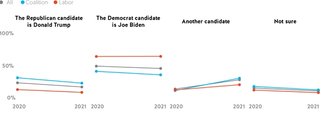
Support for Biden also declined among Coalition voters, from 34 to 26 per cent, but it remained steady with Labor voters, at approximately 64 per cent. In October 2020, Trump supporters narrowly outnumbered Biden supporters among ‘Others’ (34 versus 26 per cent), but by December 2021, this had almost entirely reversed (26 versus 32 per cent). As noted in a previous report from the USSC, while Australians still prefer Biden as president over Trump by a large margin, this preference is not as wide as it has been in other recent US presidential contests.23 Ahead of the 2008 presidential election, we found 60 per cent of Australians preferred Obama over Republican candidate John McCain (who was favoured by 14 per cent of respondents).
Section 2. Threats to and opportunities for US economic and technological power
Overview
by Dr Stephen Kirchner
The Biden administration came to office with an ambitious domestic economic agenda, exemplified by the largest ever peacetime federal spending and budget deficits in its first year. While the big spending bills the administration proposed — like the American Jobs Plan and the American Families Plan — are indicative of the administration’s determination to extend a strong domestic economic recovery from the pandemic, the fact that much of the legislation has yet to pass highlights many of the domestic political and economic constraints on the administration’s agenda.
Major spending bills have been held up as the administration tries to manage competing demands from the Democratic Party’s progressive wing and its conservatives like West Virginia Senator Joe Manchin. The magnitude of the proposed spending is a challenge from the standpoint of state capacity, with long timelines separating legislation from the delivery of new programs on the ground. As USSC Non-Resident Fellow Jennifer Jackett’s review of the measures proposed under the Innovation and Competition Act and the America Competes Act suggests, the US political system continually puts the brakes on further practical action.
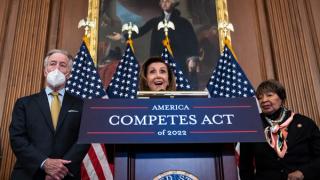
The administration’s approach relies heavily on throwing money at perceived shortfalls in US industrial and technological capacity rather than removing structural impediments on the US innovation ecosystem. The bipartisan embrace of industrial policy, symbolised best in the over two-thirds Senate support for the ‘anti-China bill,’ the Innovation and Competition Act, has yet to show that it can transcend the pitfalls of partisan politics and domestic economic rent-seeking.
Biden’s economic agenda is also inwardly, rather than outwardly, focused with domestic economic objectives prioritised over international economic engagement. In particular, new trade agreements are for the most part seen as a non-starter, lacking congressional support or presidential leadership. US allies, keen to see Biden return to the international economic rule-making space vacated by the Trump administration, will have to settle for more ad hoc and less ambitious forms of economic cooperation.
While the big spending bills proposed are indicative of the administration’s determination to extend a strong domestic economic recovery from the pandemic, the fact that much of the legislation has yet to pass highlights many of the domestic political and economic constraints on the administration’s agenda.
Issues of supply chain security loom large for the United States and its allies. The global outbreak of inflationary pressures on the back of supply chain bottlenecks has underscored the issues of supply chain resilience brought to the fore by the COVID-19 pandemic. The secular decline in the prices of durable goods has undergone a dramatic reversal, with US inflation at its highest rate since 1982.25
Inflationary pressures and the shortfalls in supply are mostly due to dramatic shifts in demand brought about by changed consumptions patterns induced by the pandemic. The slow supply response to these demand shifts was also exacerbated by under-investment in new production capacity and related infrastructure brought about by the 2020 pandemic downturn.
On balance, global supply chains did well to pivot in response to these demand shifts by increasing output as quickly as they did. No supply chain configuration, regardless of how domiciled, could have easily accommodated such massive demand shifts. Rising prices are already inducing supply responses that will ultimately see a return to pre-pandemic disinflationary pressures.
One example of this is the US supply of semiconductors is not only ensnared in this pandemic-induced shift in demand but also a key battleground in the strategic rivalry between the United States and China, as Jennifer Jackett’s contribution makes clear. As with the US response to trade competition with Japan in the 1980s, recently proposed subsidies for domestic chip manufacturing aim not only to address temporary supply shortfalls but to maintain technological dominance over China’s emerging chip sector and provide supply chain security for the critical tech sector.
The Biden administration’s so-called ‘foreign policy for the middle class,’ referred to extensively by key members of his administration, suggests the same domestic orientation as Trump’s ‘America First.’ Accordingly, integrating its domestic economic agenda with industrial and technological cooperation with allies will remain one of the administration’s biggest challenges going forward.
It is also a form of policy integration that the US Government is poorly equipped to deliver. US state capacity remains highly fragmented between domestic and international policymaking silos. Even where the international-facing arms of the US Government may want to progress alliance cooperation, the domestic-facing arms will pull attention back to domestic policy issues and priorities.

Structural headwinds to the US recovery and global leadership
by Dr Stephen Kirchner
The US economy staged a dramatic recovery from the pandemic downturn. National output now exceeds its pre-pandemic levels, although employment outcomes measured by the employment to population ratio have lagged somewhat. Despite the strong cyclical recovery, the US economy faces a number of structural headwinds that have a direct bearing on the future trajectory of US national power and global influence. These are population growth, potential output and productivity performance. These structural headwinds will weigh on the ability of the Biden administration to deliver on its promises at home and to project US power and influence abroad.
Population
In 2021, the United States recorded its slowest population growth since at least 1900, at just 0.1 per cent (Figure 2.1).26
Figure 2.1. Annual per cent change in the US population, 1900-2021

The second-lowest growth rate occurred in 1918-19, during the influenza pandemic and First World War. In absolute terms, 2021 was the first time the US population grew by less than one million people since 1937. The working-age population (aged between 15 and 64) recorded an outright decline for the third straight year in 2021.
These outcomes are partly attributable to the pandemic, which closed US borders, increased mortality and deferred births. But it also reflects longer-term trends, including record-low fertility rates. US population growth has been slowing since the early 1990s, much of which is driven by lower net international migration (NIM), the balance of migrant inflows and outflows. From a recent peak of just over one million in 2015-2016, NIM fell to just 247,000 between 2020 and 2021 (Figure 2.2).
Figure 2.2. Net international migration, 1 July 2010 - 30 June 2021
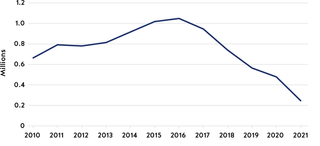
If we compare these outcomes to a counterfactual in which NIM continued to grow at its pre-Trump and pre-pandemic trend, then the United States has experienced a population shortfall of some 4.8 million persons (Figure 2.3).27
Figure 2.3. Change in the net immigrant population under different scenarios
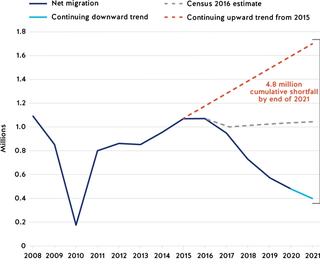
Applying recent labour force participation rates to this figure suggests a loss of 3.1 million workers compared to a no-Trump/no-pandemic counterfactual.
Like any supply shock, the shortage of workers is a drag on potential output. It is also a drag on long-run productivity growth, given the disproportionate role that migrants play in driving US innovation, new business formation and entrepreneurship.28 In the absence of catch-up migration, which appears politically unlikely, the United States will suffer a permanent loss of potential output and productivity growth.
The United States is not the only country to face demographic challenges. China also stands on the brink of an outright decline due to its ageing population. But immigration has played an out-sized role historically in promoting the dynamism of the US economy.
Potential output
Potential output is the level of economic activity achievable when the stock of labour and capital are fully employed. As Figure 2.4 (first suggested by US economist Claudia Sahm) shows, not only have estimates of US potential output been consistently revised down since 2005, but actual output has come in below potential more often than not over the same period.
Figure 2.4. US Congressional Budget Office potential GDP versus actual, 2005=1
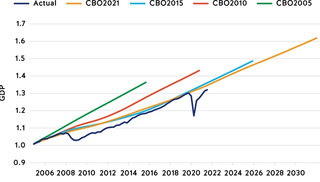
This shortfall relative to potential is due to the slow recovery from the 2008 financial crisis, as well as the pandemic downturn. Only in a handful of years immediately prior to the 2020 pandemic did the US economy grow at its estimated potential based on productivity growth and the stock of labour and capital.
If the US electorate had expectations for future income growth that looked similar to those embodied in the Congressional Budget Office’s estimates of future potential output, then those expectations have been met with disappointment. From the standpoint of 2005, US potential output in 2021 was below where it was expected to be in 2015 and its actual outcomes were weaker still. This gap between long-term expectations and outcomes helps explain the sense of disappointment in the US economy, despite episodes of short-term cyclical strength.
Productivity
Growth in potential output is a function not just of labour and capital inputs, but also of long-run productivity growth. There has been a trend in the United States towards weaker productivity growth and this weakness is heavily implicated in the global productivity slowdown of recent years given that the United States has traditionally defined the global frontier of productivity and living standards.
Figure 2.5 shows US total factor productivity (TFP) — the ratio of output to combined input of labour and capital — between 1890 and 2019 as per cent deviations from a fitted trend that allows for slower productivity growth over time.
Figure 2.5. US total factor productivity, 1890-2019, per cent deviation from trend

The fitted trend allows for a slowdown in productivity growth that is consistent with models of long-run economic growth. It is noteworthy that US TFP from the early 1980s through to the mid-2000s evolves very closely in line with this trend, albeit at a slower pace than seen during the post-Second World War boom. In the wake of the 2008 financial crisis, however, TFP underperforms in respect to this long-run trend. One would need to go back to the Great Depression in the early 1930s to find a similar period of underperformance.
Given that productivity is the main long-run driver of living standards and average wages growth29 we can see how recent productivity outcomes have disappointed expectations derived from trends observed in previous decades. As I have argued in recent USSC publications, this slowdown in the United States and global productivity growth coincides with a slowdown in globalisation that also peaked in the mid-2000s.30
Key takeaways and implications for Australia
US national power and global influence has always rested on an economic foundation. But that economic foundation has weakened in recent decades. Demographic trends are weighing on US potential output and productivity. Productivity growth has slowed below a long-run trend that already allows for the decline in productivity growth predicted by economic theory. These shortfalls relative to trends observed in previous decades help explain the sense of disappointment in the US economy relative to long-run expectations derived from those trends, as well the economic basis for the retrenchment of US power globally.
The slower trend in US productivity growth is also a headwind for Australian productivity growth given that we import trends from the global frontier of productivity and living standards traditionally occupied by the United States. US allies must recognise that the United States is likely to be increasingly resource-constrained in the absence of new sources of productivity growth.
The Biden administration’s trade agenda
by Dr Stephen Kirchner
The Biden administration has done little to define a trade policy agenda in its first year. Indeed, US trade policy is still framed in terms decided by the Trump administration. Trump’s tariffs mostly remain in place, the United States has not progressed on further trade agreements and continues to underinvest in multilateral processes and institutions. The United States has also largely vacated the global trade rule-making space, not least in the Indo-Pacific, cutting managed trade deals — in which governments set and specify trade targets as opposed to allowing market forces dictate trade flows. Such deals are not in the long-term interest of the United States or its allies.
The Biden administration’s performance to date
The Biden campaign did not articulate a comprehensive trade policy during the 2020 election campaign. It entered office with a commitment to review the Trump administration’s trade policies which saddled the United States with a managed trade deal with China, extensive tariffs on US-China bilateral trade, tariffs on steel and aluminium imports, little progress on trade agreements other than a revamped US-Mexico-Canada agreement and an impasse over appointments to the World Trade Organization’s Appellate Body.
The trade policy review process left the Biden administration struggling to articulate a coherent or positive trade policy agenda. This likely reflects differences within the administration on trade and a fundamental lack of appetite to progress a trade policy agenda that undermines a focus on domestic economic development. Like the Trump administration, the Biden administration seeks to put the domestic economy before international economic engagement, but the latter is critical for the former.
While congressional Democrats have limited enthusiasm for new trade agreements, this political constraint is compounded by almost certain Republican opposition, a reversal of the traditional partisan divide on trade policy.
Allowing the Trade Promotion Authority (TPA) to lapse in July 2021 is a strong signal that the administration does not intend to progress new formal trade agreements as opposed to ad hoc trade deals, like Trump’s phase one trade deal with China, that do not require congressional approval. Without TPA, other countries will be reluctant to negotiate trade agreements that can then be amended by Congress. At best, new agreements will be deferred as second-term agenda items. This repeats the mistake made by the Obama administration, which deferred key trade policy initiatives to late in its second term, leaving US membership of the Trans-Pacific Partnership vulnerable to a change in administration. While congressional Democrats have limited enthusiasm for new trade agreements, this political constraint is compounded by almost certain Republican opposition, a reversal of the traditional partisan divide on trade policy.
Keeping Trump’s China ‘phase one’ trade deal
The administration has allowed the Trump administration’s ‘phase one’ trade deal to continue, leaving in place the extensive tariffs imposed on Chinese imports, as well as China’s retaliatory tariffs against US exports. The incoming Biden administration saw China’s purchasing commitments made under the deal as worth preserving, even if China was bound to fall short of those commitments given the pandemic downturn in global trade. With the commitments concluding in 2021, China has met about 60 per cent of the overly ambitious targets.31 China’s commitments to an improved regime for intellectual property protection are also considered worth preserving, although China was already committed to these changes as part of its own reform agenda.

The administration signalled the possibility of a new Section 301 investigation into China’s trade practices and a recalibrated set of tariffs that are narrower in scope, but steeper in incidence, targeting those exports seen to benefit most from Chinese industrial policy.32 Section 301 allows the administration to address foreign trade practices deemed to be unfair after other multilateral processes have failed, while section 232 measures target national security concerns. This approach would mitigate some of the harm the current suite of tariffs imposes on the United States and provide leverage in the context of a potential ‘phase two’ trade negotiation.
It is in the interests of both the United States and China to defuse bilateral trade tensions, but the appetite for new negotiations on either side is limited. The expiry of the purchasing commitments, such as those on US agricultural goods, may provide Australia with some relief from the deal’s trade diversion away from Australian exporters.33
Suspending US tariffs on EU steel and aluminium
The United States and European Union suspended the Section 232 national security tariffs on US steel and aluminium imports, the associated litigation and EU retaliatory measures. Effective from 1 January 2022, a fixed volume of EU-sourced imports can now enter the United States tariff-free, with only additional volumes subject to the Trump tariffs. This tariff-rate quota (TRQ) system will help temporarily defuse US-EU trade frictions but is unlikely to be resilient to future shifts in demand for these products and provides little relief to the end-users of steel and aluminium in the United States.34
The United States is showing little interest in negotiating new legislated trade agreements like the Trans-Atlantic Trade and Investment Partnership (a US-EU agreement functionally similar to the Trans-Pacific Partnership). Therefore, it is likely that the US-EU deal on steel and aluminium will be a template for future managed trade deals, including a possible US-China ‘phase two’ deal.
Ambiguous on regional trade agreements and Indo-Pacific economic architecture
There is widespread recognition within the US policymaking community of the value in the United States joining the Comprehensive and Progressive Trans-Pacific Partnership (CPTPP), coupled with an equally widespread view that it is a non-starter in terms of both US domestic politics and administration priorities. At the very least, any US participation in that agreement would need to take place under a different banner, with US membership reframed, not in terms of domestic economic benefits, but in terms of winning a global rule-making competition with China.
There is widespread recognition within the US policymaking community of the value in the United States joining the Comprehensive and Progressive Trans-Pacific Partnership, coupled with an equally widespread view that it is a non-starter in terms of both US domestic politics and administration priorities.
The United States seeks to articulate a new Indo-Pacific economic engagement framework as a stand-in or placeholder for US membership in the CPTPP, but there is, as yet, little substantive content to that framework. While the United States remains substantially economically engaged in the region, not least in terms of foreign direct investment, the US absence from two of the largest multilateral trade deals in the region — the Regional Comprehensive Economic Partnership and the CPTPP — means the United States has largely vacated the rule-making space that will determine the future evolution of Indo-Pacific economic integration and US participation in that process.
Impasse at the World Trade Organization
The Biden administration followed the Trump administration in continuing to block new appointments to the WTO’s Appellate Body. The United States continues to articulate long-standing grievances with the functioning of the WTO, but it has yet to stipulate the conditions that need to be satisfied for the United States to consider unblocking Appellate Body appointments. This lack of clarity is a substantial obstacle to progressing a WTO reform agenda which could ultimately address US concerns and serve as a vehicle for continued US leadership of the multilateral trading system.
Australian policymakers still see a substantial role for the WTO in pushing back against China’s economic coercion and protecting Australia from trade discrimination in an era of great power geoeconomic competition. By contrast, US policymakers continue to invest very little political or diplomatic capital in sustaining the multilateral trading system.
Key takeaways and implications for Australia
The lack of US leadership on trade and trade rulemaking places an increased burden on Australian policymakers and diplomats to persuade the United States of the need for continued investment of political and diplomatic capital in both the multilateral trading system and the rules governing the evolution of greater Indo-Pacific economic integration. The biggest risk for Australia is if the lack of US leadership in global rulemaking is compounded by new managed trade deals that, like the Trump administration’s ‘phase one’ trade deal with China, discriminate against Australian commercial interests.
Australian policymakers should persuade their US counterparts that it will need to offer increased international access to US markets through formal trade agreements if it is to continue to compete in the regional trade rule-making competition with China.
Technology, innovation and allied integration
by Jennifer Jackett
Three months after taking office in January 2021, President Biden used his first address to Congress to declare his ambition for the United States to “develop and dominate the products and technologies of the future.”35 Retaining a world-leading position in areas like semiconductors, artificial intelligence, quantum and clean energy, among others, is rightly seen as critical to US economic and national security. It is also necessary if the United States is to compete with China from a position of strength and mitigate risks created by China’s increasing technological capabilities; namely, an authoritarian influence on the digital world and the challenge to the United States’ military edge. But retaining the lead requires the United States to deliver on a comprehensive national technology strategy, encompassing domestic investments, legislation, technology protection and international partnerships.
Domestic agenda ambitious but key legislation pending finalisation
The United States faces the prospect of a relative decline in its science and technology foundations — the bedrock of US economic and military power — without urgent investment in areas like human capital, research and development, advanced manufacturing and digital infrastructure. The Biden administration has lacked neither ambition nor a sense of urgency in responding to these challenges. A positive, future-focused vision has emerged, replete with plans covering supply chains,36 advanced manufacturing, semiconductors,37 infrastructure investment38 and collaboration with international partners.39 If anything, these efforts would benefit from prioritisation to use resources in areas that will have the greatest impact in both the next few years and decades ahead.

But it remains to be seen when substantial legislative proposals in Congress will deliver the additional step change needed to bolster US technological competitiveness vis-à-vis China through further practical action. The US$250 billion Innovation and Competition Act40 passed the Senate in June 2021 after deal-making on both sides. In February 2022, the House passed the America Competes Act,41 including US$52 billion to support domestic semiconductor manufacturing and increased funding for the National Science Foundation. The challenge ahead is to reconcile the two bills for presidential sign off in a timely way so implementation can get started. As Senate Majority Leader Chuck Schumer recently argued, the United States is in “an all-out race… to protect our country’s global technological edge.”42 To be sure, this is a multi-generational marathon, not a sprint, but there is still a timing imperative to kick-start major initiatives to retain and advance — rather than try to regain — a leading scientific and technological edge.
Technology protection remains strong
Executive branch actions by the Biden administration continued the Trump administration’s strong efforts to defend and slow the unwanted transfer of dual-use technologies to China. This includes the regular use of foreign investment screening, export controls and sanctions. For example, in December 2021, Chinese private equity firm Wise Road Capital and US semiconductor company Magnachip terminated a billion-dollar deal after the Committee on Foreign Investment in the United States — the interagency committee authorised to review transactions involving foreign investment in the United States — did not provide its approval due to national security risks.
To be sure, this is a multi-generational marathon, not a sprint, but there is still a timing imperative to kick-start major initiatives to retain and advance — rather than try to regain — a leading scientific and technological edge.
Regulatory actions have a vital role in protecting US economic and national security; yet the risk is that without delivering on the domestic agenda to enhance US technological competitiveness, the United States faces an imbalance in its technology strategy. Managing openness in trade, investment and academic collaboration through increased security controls carries costs. These need to continue to be balanced with initiatives to incentivise and support industry, as well as strong investment in basic research to offset risks associated with government picking technology winners through direct investment in areas like batteries.
Allied collaboration integral to US success
US strategy to maintain its technological competitiveness will also depend on the actions of technologically advanced states and major markets, including the European Union, the United Kingdom, Japan, South Korea, and India. These countries will be as consequential as the United States for leadership of world-leading research, strengthening technology supply chain resilience, and supporting international technology governance, including the development of standards and norms that align with liberal democratic values. Efforts to ringfence certain technology will also only work if US partners take similar steps through continued regulatory alignment in areas like export controls, given the global nature of supply chains. Countries like Australia with niche research capabilities, policy leadership and a strong record of regional capacity building add an important voice to global debates about technology development and norms.
The significant role of US partners has already led to growing calls in the United States and like-minded countries for a digital alliance among democracies.43 Such an alliance could provide a comprehensive plan for strategic technology collaboration to defend the technology advantage of like-minded partners, advance their collective competitiveness and assist third-party countries to improve their technology security approaches. Where appropriate, this could build on work already occurring in groupings like AUKUS, the Quad, the US-EU Trade and Technology Council, the G7, and NATO and fora such as the Prague 5G Security Conference and the Five Country Ministerial. For example, the Quad’s ‘Principles on Technology Design, Development, Governance, and Use’ provide a sound articulation of the values, security expectations and collaboration that could underpin an alliance.
Key takeaways and implications for Australia
The greatest opportunity for a technology alliance is for the United States and its partners to jointly strengthen their technological and industrial bases. This is no mean feat, primarily because it is largely not government led. The private sector plays a central role and there are differing commercial equities at play. Governments will need to focus on levers they can pull. These include reducing barriers for industry and incentivising collaboration, co-investment and cooperation in areas of comparative advantage between US and allied private firms. For example, the United States and Australia have sought to support supply chain security in critical materials through awarding a US Department of Defense technology investment agreement to Australian company Lynas Rare Earths.
An obvious area for deeper cooperation is defence industry integration. This largely comes down to the United States empowering its allies through improved export control and technology transfer arrangements. In this sense, the AUKUS partnership creates the promise of such change. Timely progress on its legal and administrative underpinnings provides a critical litmus test for the potential of allied integration moving forward.
Human capital will be the decisive factor in the ability of the United States and its partners to develop cutting-edge capabilities, build companies and market share, and maintain influence in technology standard setting.
Another issue to focus on is attracting, developing and retaining STEM talent in strategically significant fields like quantum physics. Human capital will be the decisive factor in the ability of the United States and its partners to develop cutting-edge capabilities, build companies and market share, and maintain influence in technology standard setting. Closer coordination on educational initiatives and specialised visa programs promoting mobility between allies would support a more collective approach.
Ultimately, US technology strategy needs to be long-term, multi-faceted and consisting of a carefully calibrated mix of domestic and international policy initiatives. Yet, there is still a need for the United States and its partners to act quickly if they are to put in place the necessary foundations to advance their competitiveness moving forward — including on a possible technology alliance. The Biden administration has made many commitments thus far, giving reason to be positive about cooperation with partners. Delivering tangible progress on these in the year ahead will be key to maintaining the collective technological leadership position of the United States and its partners to support their future economic prosperity and national security, and to be able to compete with China from a position of relative strength.
Supply chain resilience
by Dr John Lee
In June 2021, the White House released the Biden administration’s 100-day supply chain management review44 under Executive Order (EO) 14017 on America’s Supply Chains.45 Although the review was triggered by concerns about supply chain disruptions and shortages caused by the global pandemic, the focus was on American vulnerabilities caused by an over-reliance on China. The issue of over-reliance gained prominence when the pandemic saw China lock down in early 2020 and take decisions to secure exclusive Chinese access to critical medical and health products at the expense of its trading partners.
In the first 100 days of Biden’s presidency, his administration:
- Maintained the Trump-era tariffs imposed on China.46
- Issued EOs dealing with analysing and securing supply chain resilience in critical and/or strategic products such as semiconductor manufacturing and products, high-capacity batteries, critical minerals, pharmaceuticals and pharmaceutical ingredients.47
- Issued an EO strengthening ‘Buy American’ laws and policies relevant to federal government procurement.48
- Improved compliance and enforcement of Trump-era measures against the financing and trading of companies which benefit Chinese military corporate entities and organisations. This included subsequent Chinese entities being added to the Entity List which bans them from buying US-origin technology.49
- Announced the formation of a Department of Defense China Task Force reviewing US defence-industry supply chains in critical technology and hardware used in US defence systems.50
- Announced a US$2 trillion infrastructure package to help develop supply chains for clean-energy sectors such as electric vehicles (EV), EV batteries and charging stations, and R&D in clean-energy technologies.51
Continuities and differences
As with the Trump administration, there is acceptance across the administration that the United States is engaged in comprehensive competition and rivalry with China and this includes significant non-military elements, such as economics, trade, technology and finance. The administration’s emphasis on domestic resilience, managing supply chain vulnerabilities, enhancing national power and security, and ensuring Americans receive a greater share of the benefits of economic interactions with other countries is also a continuation of what occurred during the Trump administration.
However, there have been some rhetorical, substantial, and institutional changes in approach that contrast with the prior administration.
President Biden is not as overtly critical of the international trade and global economic system even though he agreed with his predecessor that Americans ought to be benefitting more from external material interactions with the world and that there are structural problems with international trade and the World Trade Organization.
President Biden readily points to serious problems and limitations with the existing rules and enforcement mechanisms of the World Trade Organization and agrees with Trump that the WTO appellate panel has consistently overstepped its historical mandate by (illegitimately) formulating rules and policies. At the same time, however, recent US nominee to the WTO Maria Pagan indicated that the Biden administration is prepared to work with the WTO to reform aspects of it and restore the functioning of the Appellate Body.52 This is a more conciliatory approach than occurred under the Trump administration.

The Biden administration has also linked its approach to supply chain resilience with a promise to work better with allies and partners when it comes to China. The Trump administration deserves credit for developments such as including Australia and the United Kingdom in the US National Technology Industrial Base,53 which helped pave the way for the Biden administration’s AUKUS agreement; an agreement with Australia on securing critical minerals such as rare earths; and cooperation with Australia and Japan in the South Pacific.54 Biden has built upon these achievements and continued using existing multinational arrangements to entrench allied coordination and cooperation.
For example, Biden used a Quad virtual leader’s meeting held on 12 March 2021 to launch a critical and emerging technology working group to better cooperate on international standards and joint production of technologies which will become more important in the future.55 The Biden administration has emphasised cooperation with allies such as Japan in securing production and supply chains of sensitive products such as semiconductors.
Although the general objective of ‘creating high paid American jobs’ through onshoring and reshoring of supply chains is retained, there is growing emphasis on the importance of creating ‘safe and reliable’ supply chain ecosystems in friendly countries if onshoring is not achievable or cost-effective.
There are other points of difference:
- Compared to the Trump administration, there is much less criticism of allies when it comes to sharing the cost and burdens of military and non-military arrangements, including redirecting supply chains away from China.56
- The previous administration put more emphasis on corporate tax policy and other market-based incentives to attract capital and encourage the return of supply chains into the United States57 while the Biden administration has focused on injecting large amounts of federal funding to help fund investments to support the production of critical goods.
- While the Trump administration relied heavily on EOs58which can be implemented quickly, Biden prefers substantial reviews to arrive at whole-of-government approaches between the departments of commerce, energy, defence, transportation, homeland, and health and human services. While this is designed to implement for more comprehensive and systematic measures, it has led to delays caused by disagreement between different agencies and departments. However, if the Republicans regain control of the House and possibly Senate after the midterms in November 2022, Biden is likely to increasingly rely on EOs to achieve guaranteed if transient policy outcomes.
- The Trump administration took a far more active role in coaxing and coercing corporate leaders, identifying and praising firms for making decisions helpful to national objectives, and shaming firms that were not.59 In contrast, the Biden administration has had fewer positive and negative interactions with key leaders in the US business community.
- The previous administration placed greater reliance on trade policy, or threats associated with trade policy, in the form of tariffs and export and import bans to incentivise and coerce firms to shift supply chains. In contrast, the Biden administration has been slow to develop trade policy, with geoeconomic policy primarily being driven by the national security establishment rather than the US Trade Representative or Treasury and Commerce Departments. That domestic economic and industry policy is still largely shaped by the non-national security establishment runs the risk of poor coordination between international geoeconomic strategy and domestic economic policy.
Key takeaways and implications for Australia
While the Biden administration recently released its Indo-Pacific Strategy, the absence of a compelling (let alone comprehensive) regional and global trade and economic statecraft strategy means that US leadership in the Indo-Pacific is largely being pursued using a national security and geopolitical framework and mindset. In this context, multinational strategic, economic and technological cooperation will continue to occur through platforms such as the Quad and AUKUS. The latter has built on ground prepared by the Trump administration and has the potential to evolve into a wide-ranging and profound military, industrial and technological sharing agreement even if it is limited to cooperation in strategic and military sectors.
When it comes to supply chains, the Biden administration has accepted there are substantial limits to the extent to which the US government can incentivise or demand businesses to relocate supply chains in the United States when global supply chains have become more dispersed and less vertically integrated.
When it comes to supply chains, the Biden administration has accepted there are substantial limits to the extent to which the US Government can incentivise or demand businesses to relocate supply chains in the United States when global supply chains have become more dispersed and less vertically integrated. This has led to an emerging ‘small yard, high fence’ mindset in being more circumspect and precise about the specific technologies where decoupling from China can and ought to occur.
In this context, it is in Australia’s interest to:
- Link US support, including through the US Development Finance Corporation, for securing supply chains in allied and friendly countries. The creation of safe and secure globalised supply chain ecosystems — rather than complete onshoring — is essential to US resilience and the lowering of costs.
- Leverage bilateral and specific multinational arrangements such as AUKUS in creating safe and secure multinational supply chains.
- Institutionalise pathways for Australian content expertise and expertise in plans for US-based production and supply chains. This includes congressional supply chain legislated initiatives and funds. Australian content could also be part of a ‘trusted network’ system as is necessary with some technologies.
- Urge the fast-tracking of a US trade policy that establishes rules and regulations that underpin the creation of safe and secure ecosystems.
Section 3. US power and position in the Indo-Pacific
Overview
by Ashley Townshend and Dr Peter K. Lee
The Biden administration has repeatedly vowed that it is “intensifying” its focus on the Indo-Pacific and working to “revitalise” the United States’ regional alliances and partnerships to collectively maintain “a free and open, connected, prosperous, secure, and resilient” order.60 But it has not acted on this agenda with the urgency required. Despite the administration’s recognition that “what happens in the Indo-Pacific will, more than any other region, shape the trajectory of the world in the 21st century,” its foreign policy bandwidth through 2021 was largely absorbed by internal policy reviews, consultations with allies and partners, and the delicate management of crises in the Middle East and Europe.61
One year, of course, is not the measure of a presidency. And the administration did indeed advance some important Indo-Pacific objectives, such as settling contentious defence cost-sharing talks with Japan and South Korea, reviving a visiting forces agreement with the Philippines, convening the first in-person leaders’ meeting of the Quad, and expanding the Australia-US Force Posture Initiatives on their 10th anniversary. Still, with the exception of the Quad’s rapidly growing efforts to provide public goods to the region, these actions were mostly about correcting the course of US policy after four years of Donald Trump — rather than advancing new and tangible strategic priorities in the region.
Outside the Quad’s rapidly growing efforts to provide public goods to the region, Biden’s approach to Indo-Pacific alliances was mostly about correcting the course of US policy after four years of Donald Trump — rather than advancing new and tangible strategic priorities in the region.
Fortunately, the Biden administration recognises that restoration of US regional policy alone will be insufficient to secure a favourable balance of power and influence in the Indo-Pacific. To advance a more ambitious strategy, it has sought, with some success, to revise the US approach to empowering key regional allies. The September 2021 establishment of the Australia-United Kingdom-United States (AUKUS) defence technology and industrial partnership and its flagship nuclear-powered submarine project was the high point of this effort. Alongside a wider agenda for trilateral cooperation on select emerging technologies, the AUKUS partnership is heralded by some as a costly, long-term commitment to the Indo-Pacific balance of power, even as others criticise it for being a vague proposal incapable of meeting near-term requirements.62 In this regard, the AUKUS partnership is emblematic of wider challenges the United States faces in trying to reconcile future-oriented policy reforms to compete with China over the long term with timely and tangible implementation to bolster US presence and influence in the Indo-Pacific today. This will remain a difficult balancing act.
Compounding this problem is the fact that the Indo-Pacific still remains underrepresented in the distribution of US attention amidst competing global priorities. President Biden carried through with his commitment to withdraw US forces from Afghanistan and end combat operations in Iraq. But these strategically sensible decisions did not translate into a substantial re-focus on the Indo-Pacific theatre. This was partially due to geopolitical developments outside of the administration’s control — such as Russian coercion in Ukraine and Iran’s resurgent nuclear ambitions — which the US foreign policy community still finds difficult to put in strategic perspective. Just as concerning from an Indo-Pacific perspective is that key policy initiatives designed to mobilise US resources for the region — like the Pentagon’s Global Force Posture Review, an assessment of US military presence overseas — have largely maintained existing commitments, rather than decisively shifting to prioritise deterrence against China and shaping efforts in the region.

Without a doubt, the most glaring failure of US commitment to the Indo-Pacific has been in the economic domain. With the Regional Comprehensive Economic Partnership (RCEP) entering into force in 2022 and China applying to join the Comprehensive and Progressive Agreement for Trans-Pacific Partnership (CPTPP), the United States finds itself outside the region’s two most important trading blocs. Despite the White House’s insistence that an Indo-Pacific Economic Framework is in the offing, the collapse of the free trade consensus in US politics bodes poorly for significant re-engagement in regional economic fora. This will be particularly intense in the lead up to the 2022 midterm elections when free trade could potentially be used as a wedge. Washington’s inability to develop an economic strategy for the region — and thereby compete with the source of Chinese influence and on the issues that drive regional alignment preferences — appears unlikely to change anytime soon.
All is not lost. If Biden’s first year in office yielded important resets with allies and partners, new processes, and some ambitious long-term initiatives, the remainder of his term has the potential to advance a competitive US strategy for the region. This, at least, is what Biden’s foreign policy team says it wants to achieve. Forthcoming US strategy documents, like the National Security Strategy and National Defense Strategy, should provide a clearer outline of the White House’s objectives — but must be accompanied by the requisite resources to translate these goals into regional reality.
Key areas of focus should include a clearer articulation of long-term US objectives vis-à-vis China, more focused efforts to empower regional allies, substantial investment in a more distributed and resilient Indo-Pacific force posture, greater engagement with Southeast Asian countries at the presidential level, an embrace of limited regional trade integration through the Indo-Pacific Economic Framework, an acceleration of defence industrial and export control reforms, and presidential leadership against US protectionism. Taking these and other steps will set the United States on a surer footing to maintain a favourable balance of power and influence in what the Biden administration correctly recognises as the world’s most consequential region.
US alliances and partnerships
by Tom Corben and Dr Peter K. Lee
Biden’s pledge to “reinvigorate and modernize” US alliances and partnerships has been central to his foreign policy agenda.63 In March 2021, Secretary of State Antony Blinken and Secretary of Defense Lloyd Austin labelled US allies “force multipliers.”64 Austin’s announcement of “integrated deterrence” as a new operating concept further emphasised the need to harness US power across different warfighting domains, military services, allies and partners, and all instruments of national power.65 In the secretary’s words, emerging threats and technologies require the United States “to coordinate better, to network tighter, and to innovate faster” with its allies and partners.66
On balance, however, the administration’s first year was primarily focused on repairing these relationships. In the wake of Trump’s erratic and transactional approach towards allies, the Biden team quickly settled contentious defence cost-sharing talks with Japan and South Korea, restored the Visiting Forces Agreement with the Philippines, hosted the first in-person leaders’ meeting of the Quad, and updated the Australia-US Force Posture Initiatives on their 10th anniversary.67 After a slow start, the White House also dispatched senior officials to the region for meetings with a number of critical states in Southeast Asia.68
But the challenge is to close the gap between ambitious pledges and immediate outcomes, while minimising the negative effects of a dual-track regional strategy among regional allies and partners, especially as regards the mostly hedging states of Southeast Asia.
But restoring alliances and partnerships alone will be insufficient to maintain a favourable balance of power in the Indo-Pacific.69 The growing prominence of minilateral partnerships like the Quad and the AUKUS partnership reflects an awareness of the kind of creative thinking required from Washington to succeed in the Indo-Pacific. But the challenge is to close the gap between ambitious pledges and immediate outcomes, while minimising the negative effects of a dual-track regional strategy among regional allies and partners, especially as regards the mostly hedging states of Southeast Asia.
The Biden administration’s performance to date
Strengthening like-minded minilateral coalitions is an important way to make US alliances and partnerships more flexible and effective. In many respects, it continues a trend from the second Obama term towards prioritising what Vice President Kamala Harris last year called “results-oriented groups,” in addition to leveraging multilateral institutions and bilateral alliances.70 In November 2021, National Security Advisor Jake Sullivan alluded to a “latticework” approach that is “more flexible, ad hoc, more political than legal, sometimes more temporary than permanent.”71 Secretary Blinken outlined a five-layer policy towards allies and partners that included strengthening treaty alliances, fostering cooperation amongst allies, “knitting” allies and partners together, engaging new strategic partners in Southeast Asia, and connecting key Indo-Pacific relationships with “unmatched” alliances and partnerships in Europe.72

The signature accomplishments of this latticework agenda were the September 2021 announcement of the Australia-United Kingdom-United States (AUKUS) defence technology and industrial partnership and the Quad leaders’ meetings. The AUKUS partnership set out an ambitious proposal for Australia to construct eight nuclear-powered submarines with US and British technical and industrial support, in addition to deepening cooperation on emerging technologies. It was significant because it overcame longstanding US opposition to sharing submarine nuclear-propulsion technology with allies in a rare “one-off” deal, while, in principle, setting up a mechanism to expand Australian access to US and UK defence-related science, technology, industrial bases and supply chains.73
The elevation of the Quad to a leaders’ level summit demonstrated the administration’s commitment to linking up capable allies and partners to deliver near-term dividends. Indeed, the Quad has quickly developed a robust cooperative agenda focused on delivering common public goods to the region. Despite some initial setbacks, the Quad Vaccine Partnership has already provided more than US$1 billion in support and delivered more than 500 million vaccines to Southeast Asia and the Southwest Pacific.74 The leaders’ meetings covered diverse issues, including climate change, critical technologies, infrastructure, governance, space and standard-setting, explicitly tying efforts in these categories to other global-level institutions and initiatives.75
After being slow to re-engage with Southeast Asia, senior US officials visited the region in the second half of 2021, but with a focus on countries where the United States could make “easy wins” — the Philippines, Singapore and Vietnam — rather than more even-handed engagement with the region.
Yet, these minilateral efforts, though designed to support South and Southeast Asian nations, have not included them as participants. After being slow to re-engage with Southeast Asia, senior US officials visited the region in the second half of 2021, but with a focus on countries where the United States could make “easy wins” — the Philippines, Singapore and Vietnam — rather than more even-handed engagement with the region.76 Secretary Blinken’s trip to Indonesia in December 2021, though low on substance, signalled the administration’s awareness that the selective engagement of only nations sharing common security interests was not the right approach.
Meanwhile, President Biden’s December 2021 Summit for Democracy came across as a poor way to advance US influence in Southeast Asia. With only three of ASEAN’s 10 members invited (Indonesia, Malaysia, and the Philippines),77 the risks of premising US regional strategy on values ahead of shared interests were on full display.78 It remains to be seen how this dual-track approach between minilateral groupings and broader engagement will unfold on different issues. On the AUKUS partnership, for example, while some ASEAN countries expressed concerns and others backed the new partnership, a number of Southeast Asian experts observed that such minilateral groupings were a response to ASEAN’s limitations and did not undermine its centrality.79
Key takeaways and implications for Australia
There is an emerging shift in Washington’s approach to underwrite the strategic choices and capabilities of its allies and partners. No longer able to uphold the regional order alone, the United States appears more willing to empower its allies and partners to defend themselves and contribute to collective deterrence in more substantial ways.80 On the one hand, Washington has “stepped in” to expand allies’ access to advanced technologies and platforms through new mechanisms like the AUKUS partnership. On the other hand, it has also “stepped out” of the way of allies’ own self-strengthening efforts, illustrated by the termination of the US-South Korea Missile Guidelines in May 2021 to remove outdated US restrictions on South Korea’s ballistic missile and space research programs.81
But this has not been a uniform process. Indeed, questions remain over the extent to which Washington will be willing to facilitate empowerment when its strategic preferences do not fully align with those of allies or partners. For example, the pending US decision on whether to sanction India for its purchase of Russian S-400 missile defence systems under its Countering America’s Adversaries Through Sanctions Act (CAATSA) will be a litmus test of Washington’s ability to reconcile the empowerment of Indo-Pacific partners with its other geostrategic priorities. Moreover, enduring US domestic political factors continue to impede deeper integration with even close allies. For instance, restrictive export controls that have historically limited closer technology sharing between the United States and its most trusted allies will be difficult to dismantle and may frustrate initiatives like the AUKUS partnership.82
The prospects of transatlantic cooperation in the Indo-Pacific
The Biden administration’s strong transatlantic credentials and commitment to repairing relations with Europe raised concerns among Indo-Pacific allies about a potential shift in US regional priorities. Transatlantic cooperation was undermined by two crises: European criticism of the chaotic withdrawal from Afghanistan and the French government’s fury at AUKUS, which was announced just a day before the European Union released its long-awaited strategy for the Indo-Pacific.
These diplomatic imbroglios seem a distant memory now the United States and its European allies face the reality of a full-scale Russian invasion of Ukraine. Given the seismic impact of the events unfolding in Eastern Europe, worries abound that the acuteness of this security crisis might demote the imperative of transatlantic coordination and cooperation on China and their Indo-Pacific strategies. At the moment, such efforts appear inchoate at best and mostly limited to trade and technology talks.83 Yet, before “Europe’s 9/11” happened, 2022 was poised to be an important year for the course of transatlantic cooperation in the Indo-Pacific. This was primarily due to the publication of key strategies and the crystallisation of domestic politics in the leading European states.
First, following a number of defence initiatives put forward84 over the past half a decade,85 the European Union is set to adopt its first common threat analysis and signal the extent to which it sees itself evolving as a military actor in a Strategic Compass86 in March 2022. There remains widespread criticism87 of the European Union for the absence of a European consensus on defence priorities and the perennial mismatch between instruments the European Union wields and the spectrum of security challenges it identifies.
The draft version of the Strategic Compass makes several mentions of the Indo-Pacific and singles out coordinated maritime presence as the highest priority in the region. While several regional partners are alluded to, the United States is not mentioned explicitly in the context of Indo-Pacific coordination and Australia was omitted from the document altogether. Moreover, the European Union recently took steps to make its external action more coherent in the provision of official development assistance with the launch of the Global Gateway88 initiative, which is intended to be an alternative to the Belt and Road Initiative in that it would support infrastructure development in the Indo-Pacific to complement US89 and Australia-led90 initiatives.
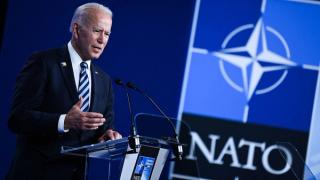
Another key strategic document will be unveiled at NATO’s Madrid Summit in June 2022. The alliance’s new Strategic Concept will replace the 2010 version,91 which made no mention of China and saw most security challenges in the context of threats from non-state actors and crisis management outside the transatlantic space. This time around, NATO’s global partnerships,92 including that with Australia, will be an important feature of the Strategic Concept. This is part of the endeavour to elevate the importance of cooperative security — NATO’s core task since 2010 — and particularly in the context of coordination with Indo-Pacific partners to address global challenges ranging from traditional security matters to the emerging and disruptive technologies.
The European transatlantic three — France, Germany, and the United Kingdom — will be even more important due to their agenda-setting roles and the scope of their foreign policy ambitions. At the beginning of 2022, France took over the six-month rotating presidency of the Council of European Union,93 while Germany will be presiding over the G794 for the rest of the year. If re-elected by French voters in April 2022, French President Emmanuel Macron will have an opportunity to deliver upon his long-standing vision of France as Europe’s true Indo-Pacific power and push for increasing the European Union’s strategic autonomy.95 The new German coalition government96 is in a position to be more in favour of pushing back against China’s unfair trading practices and violations of international law, thus opening the space for closer cooperation with the United States.
Lastly, the United Kingdom is already on the diplomatic march in the Indo-Pacific given its quest to build global influence in the post-Brexit era, as evidenced by the fact that it plans to join the Comprehensive and Progressive Agreement for Trans-Pacific Partnership (CPTPP) in 2022.97 This will add to the more recent developments aimed at building the United Kingdom’s presence through initiatives such as AUKUS, joining of the Association of Southeast Asian Nations (ASEAN) as a dialogue partner,98 and deployment of a maritime task force.99
While on a strategic level the prospects of transatlantic coordination in the Indo-Pacific are more promising than they have been in recent years, there is no doubt the severity of the security crisis in Europe has shifted priorities on the foreign policy agenda. At the same time, the extent of coordination between US and European allies and partners in their response to Russia’s aggression, along with a major turn in strategic thinking in the key capitals in Europe might prove to be beneficial for a sustained cooperation on other fronts in the long term.
US regional defence strategy
by Ashley Townshend and Tom Corben
Strengthening US military posture in the Indo-Pacific and advancing collective defence arrangements with key allies and partners are core requirements for sustaining a favourable regional balance of power.100 But the Biden administration — like its predecessors — has so far struggled to treat this agenda as an urgent priority. Although the Pentagon has labelled the Indo-Pacific its “priority theater” and China its “pacing threat,” it has not acted swiftly to improve the ability of the United States and its allies to strengthen deterrence against China over the next five years. Nor has the US withdrawal from Afghanistan led to a refocusing on the Indo-Pacific as many in the region had hoped — a situation made worse by the Russian invasion in Ukraine and attendant concerns in Washington over European security.
Though there have been some positive developments on Indo-Pacific defence arrangements — such as the expanded Australia-US Force Posture Initiatives and establishment of the AUKUS defence technology and industrial partnership101 — such initiatives will be slow moving. Against the backdrop of concerns over the United States’ capacity to continue underwriting the Indo-Pacific strategic order in the near term, there is a growing sense of frustration among key allies and partners about Washington’s distraction and slow progress on regional defence.102
The Biden administration’s performance to date
Despite initial fears the Biden administration might substantially cut defence spending, funding for the Pentagon is expected to rise slightly in nominal terms. But it is still less than the three to five per cent real growth that defence experts on both sides of politics argue is necessary to maintain an effective Indo-Pacific slice of the US global defence strategy.103 Of greater immediate concern is that the Pentagon’s US$740 billion FY22 budget, authorised by Congress in December 2021, prioritises long-term military modernisation at the expense of sufficient investment in the acquisition and fielding of capabilities that can improve the United States’ military position vis-à-vis China in the 2020s.104 Put simply, the Pentagon is still underinvesting in the immediate requirements of its Indo-Pacific posture.
This concern was compounded by the administration’s handling of the Pacific Deterrence Initiative (PDI) — a congressionally mandated priority to drive additional funds to US Indo-Pacific Command for pressing regional defence needs. Following the Pentagon’s decision to apportion most of the US$7.1 billion PDI request into research and procurement accounts with little bearing on the present-day Indo-Pacific military balance, Congress moved to repair the initiative.105 The revised PDI will drive some new investment in regional military posture, logistics, air defences and radars, and capacity-building programs.106 Even so, approximately three-quarters of the PDI remains focused on sustaining “baseline steady state presence” rather than advancing new posture initiatives.107 Congress may have established a baseline upon which to expand PDI in future budgets, but this year’s ordeal harmed efforts to quickly bolster the US regional position and intensified regional concerns over Washington’s commitment to effective forward military presence.
Congress may have established a baseline upon which to expand the Pacific Deterrence Initiative in future budgets, but this year’s ordeal harmed efforts to quickly bolster the United States’ regional position and intensified regional concerns over Washington’s commitment to effective forward military presence.
The administration only fared marginally better in realigning US global military posture to focus on Indo-Pacific priorities. On the positive side, the announcement of a suite of Enhanced Force Posture Initiatives with Australia represented real progress. Like AUKUS, these signalled US willingness to approach collective defence objectives creatively; and will drive step-changes in US forward presence through more frequent rotations of US air and naval assets and the establishment of a “combined logistics, sustainment, and maintenance enterprise to support high-end warfighting and combined military operations” from Australia.108 But other posture developments have largely amounted to consolidation rather than expansion of US presence in the Indo-Pacific. While the much-anticipated Global Force Posture Review made internal reforms to Pentagon processes — which may be useful in adjudicating future Indo-Pacific posture requests — it failed to deliver any substantial new initiatives for the region.109 Meanwhile, the ostensibly “new” posture arrangements of 2021 in South Korea, Guam, the Philippines and Singapore actually represented a formalisation of pre-existing initiatives or a return to prior arrangements circa 2014.110
Brewing crises in Europe and the Middle East continue to cast doubt over Washington’s capacity to prioritise defence requirements for the Indo-Pacific. The end of operations in Afghanistan and reductions in high-end air defence and strike deployments across the Middle East suggest that Biden was prepared to make tough trade-offs in the interests of strategic priorities.111 Yet so-called “over-the-horizon” counterinsurgency operations and persisting efforts to deter Iranian adventurism continue to demand a sizable US presence in the Middle East,112 limiting the windfall from the withdrawal and future drawdowns.113 Sustaining the administration’s measured response to Russia’s provocations around Ukraine will be necessary to ensure that events in Europe do not drain resources from the long-awaited Asia pivot.114

Key takeaways and implications for Australia
The Biden administration’s lack of urgency on Indo-Pacific defence strategy should worry allies like Australia. Yet the silver lining is that many of its best regional defence initiatives have come from US allies themselves. The AUKUS partnership and the Enhanced Force Posture Initiatives highlighted the success of Australian advocacy in Washington over previous years,115 while an expansion of US-Japan defence technology cooperation tells a similar story about Tokyo.116 Going forward, Indo-Pacific allies should leverage the Biden administration’s readiness to support these and other initiatives that will empower them to do more in the region.
Canberra should continue to push for timely progress on key alliance initiatives that both underwrite US regional strategy and maximise payoffs for Australia. The top priority will be to redouble advocacy for reforming US export control processes to streamline regulations for close allies like Australia and the United Kingdom. Doing so is essential for establishing Australia’s Guided Weapons Explosive Ordinance Enterprise, realising the full promise of AUKUS and ensuring Australia’s effective integration into the US National Technological and Industrial Base (NTIB).117 To amplify these efforts, Australia should caucus more with regional allies like Japan that face similar barriers to industrial and technological cooperation with the United States,118 coordinating efforts to pursue reform with key parties in Congress, the State Department, Treasury and industry.
Australia should also press the United States to expand and accelerate combined strategic planning with allies. A credible strategy of collective deterrence requires deeper consensus between Indo-Pacific allies and partners on when, where and how to address shared defence challenges.119 The Biden administration seems to have recognised this reality — seeking support from key allies on the importance of Taiwan’s security,120 and exploring contingency planning with Japan and Australia.121 But while a high-end conflict over Taiwan is the Pentagon’s “pacing scenario”,122 regional allies worry about Chinese military coercion across a far wider range of lower intensity and hybrid scenarios. Australia should ensure that prospective updates to alliance strategic planning reflect this reality.123 Indeed, this is crucial to avoiding expectation gaps between the United States and its allies on appropriate responses to a range of regional crises, and to harmonise allied self-strengthening efforts with the US military’s own plans for the Indo-Pacific.124
What is the AUKUS partnership?
by Tom Corben
The opportunity
The Australia-United Kingdom-United States (AUKUS) defence technology and industrial partnership is a new trilateral partnership intended to “deliver advanced defence and technology capabilities” and “enhance joint capability and interoperability” between all three partners.125 The partnership will focus on deepening integration between the three nations in defence-related science, technology, industrial bases and supply chains, with an initial emphasis on cyber capabilities, artificial intelligence, quantum technologies and new undersea capabilities.
The inaugural AUKUS project is to support Australia’s acquisition of nuclear-powered submarines and the necessary infrastructure to support them. These vessels will strengthen Australia’s ability to deter major power aggression and meet offshore threats to Australian interests in the region, both independently and in a collective context,126 as called for in the 2020 Defence Strategic Update.127 The AUKUS partnership also provides opportunities for Australia to contribute to new and existing American- or British-led capability and technology projects.128 An agenda for such cooperation is expected to be finalised in early 2022.129
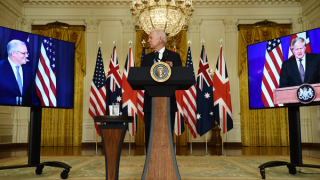
Crucially, progress is already being made. An initial 18-month study “to define the optimal pathway” toward this goal is underway, while an Exchange of Naval Nuclear Propulsion Information Agreement was signed by the three nations in November 2021.130 More recently, senior officials convened in Washington in December 2021 for the first meetings of two AUKUS Trilateral Joint Steering Groups, on Advanced Capabilities and Australia’s Nuclear-Powered Submarine Program.131
The challenge
Australia must overcome several challenges to maximise the benefits of the AUKUS partnership. Above all, the 18-month study will need to identify a roadmap for developing sufficient shipyard and maintenance capacity and technical know-how to sustain a fleet of nuclear-powered submarines. Australia will also likely need to consider an interim capability to fill the gap between now and when the first nuclear submarine arrives,132 sometime before 2038 according to Defence Minister Peter Dutton,133 notwithstanding the $6.4 billion life extension program for Australia’s six Collins-class submarines.134
Most importantly, Canberra will need to convince Washington to take down longstanding barriers to two-way defence industry and technology integration. On this note, it is unclear how the AUKUS partnership fits into Australia’s longstanding efforts to secure greater participation in the US National Technology and Industrial Base. The expansion of this framework to include the United Kingdom and Australia in 2017 was intended to create a “defence free trade zone,” but has failed to live up to its potential.135 Addressing these issues will be crucial to realising the promise of the AUKUS partnership.
US China policy and strategic competition
The competitive nature of US-China relations has only intensified and deepened under the Biden administration. President Trump’s China policy was an inconsistent mix of trade mercantilism, ideological rivalry, and “great power competition.” President Biden has preserved these underlying assumptions, while also framing the relationship in more values-based terms. In his first press conference in March 2021, Biden set the tone for how he would approach China, declaring “this is a battle between the utility of democracies in the 21st century and autocracies.”136 At the same time, the administration wants to avoid military conflict and aims to cooperate with Beijing on issues like climate change and non-proliferation. In the words of Secretary Blinken, the US approach to China will be “competitive when it should be, collaborative when it can be, and adversarial when it must be.”137
Yet, absent from Biden’s approach to China has been a sense of what he envisages for US-China relations in the long term. “Competition” is the administration’s buzzword, but what “success” looks like is harder to discern.138 Although the US Department of Defense set up a China Task Force in early 2021 and the White House recently released its Indo-Pacific Strategy, there is still no China strategy or declared set of objectives for US China policy.139 To effectively compete with China for influence in the Indo-Pacific, the United States needs to de-emphasise the ideological agenda and set forth a clearer vision of what kind of long-term relationship it seeks with China.

The Biden administration’s performance to date
Biden sought to strengthen two elements of US power vis-à-vis China: US economic strength and global leadership. This led the administration to maintain the trade war with China in defence of “fair trade” and “managed trade,” and to continue dealing with China bilaterally rather than seeking arbitration through the World Trade Organization.140 US trade officials continue to press China to honour its pledge to purchase more US products and expand market access under the Phase One Agreement from the Trump era.141 Globally, senior State and Defense officials, many of whom built their careers working on transatlantic relations, emphasise cooperating with Europe to counter China in global forums.142
To effectively compete with China for influence in the Indo-Pacific, the United States needs to de-emphasise the ideological agenda and set forth a clearer vision of what kind of long-term relationship it seeks with China.
The United States also tried to prioritise deterring China’s actions in the Indo-Pacific. Militarily, the Pentagon settled on describing China as the top “pacing challenge,” connoting that its military modernisation will be the benchmark for US military planning.143 It wants to counter some of China’s technological developments such as testing a hypersonic missile and improving its nuclear arsenal. The administration stepped up its diplomatic and military support for Taiwan in the face of increased People’s Liberation Army Air Force flights into Taiwan’s Air Defence Identification Zone, including persuading allies like Australia, Japan, and South Korea to reference Taiwan in their joint statements with the United States.
US-China military and trade disputes have, nonetheless, been accompanied by attempts at cooperation, even though these have not altered the overall competitive settings of the relationship. At the administration’s first formal sit-down with Chinese leaders at the March 2021 Anchorage meeting, both sides firmly set out their positions but failed to make meaningful progress. Throughout the year, US efforts to cooperate with China focused on global challenges, notably the “US-China Joint Glasgow Declaration on Enhancing Climate Action in the 2020s” reached during the COP26 climate change talks in November.144 This provided a basis for Biden’s virtual meeting with Xi Jinping the following week, where he highlighted the need to ensure “some common sense guardrails” in areas such as crisis management.145 The two sides identified additional areas for potential cooperation, including energy supplies, Iran, North Korea and Afghanistan, as well as noting the need to address challenges to “strategic stability” in the US-China military relationship, including the possibility of nuclear arms talks.146 On these issues, Biden emphasised that his responsibility was to “ensure that the competition between our countries does not veer into conflict, whether intended or unintended.”147
Key takeaways and implications for Australia
The Biden administration has started laying the foundations for long-term competition against China, including an ideological dimension that echoes the Cold War.148 Many of the region’s small and middle powers are instead trying to find a modus vivendi with China that accommodates its economic rise, including membership in regional trade blocs, while strengthening their ability to defend their interests against its coercive practises. A US China policy that only focuses on the latter will be insufficient.
From the mixed-messaging of the Summit for Democracy to the unwillingness of most Asian countries to join the diplomatic boycott of the Beijing Winter Olympics on human rights grounds, the United States will struggle to win support based on political values in a region as diverse as the Indo-Pacific.
Australia and the United States agree on most of the challenges posed by China’s actions, but their economic responses remain significantly apart — notwithstanding Secretary of State Blinken’s commitment that the United States would not leave Australia “alone on the field” in the face of China’s coercion.149 For example, the Australian Government declined to impose its own retaliatory tariffs on China, instead submitting wine and barley cases to the WTO, and it ratified the Regional Comprehensive Economic Partnership in November 2021 together with China.150
Framing US-China competition as the result of China’s authoritarian political system — as opposed to its coercive actions — is unlikely to resonate in the region. From the mixed-messaging of the Summit for Democracy to the unwillingness of most Asian countries to join the diplomatic boycott of the Beijing Winter Olympics on human rights grounds, the United States will struggle to win support based on political values in a region as diverse as the Indo-Pacific. It will also make US engagement with strategically important non-democratic states like Vietnam look hypocritical — something that Australia has carefully avoided.
Shifting US positions on Taiwan?
Taiwan has become the key flashpoint in US-China relations. The tempo of Chinese incursions into Taiwan’s air defence identification zone increased significantly in 2021 and raised fears of a potential clash sparking a wider conflict.
Australia’s potential role in any conflict is also the subject of intense domestic debate. Ever since the United States severed official diplomatic ties with Taiwan and enacted the Taiwan Relations Act in 1979, it has maintained a policy of ‘strategic ambiguity’ regarding what it would do in the event of a Cross-Strait conflict. This was to restrain Taiwan and deter China from trying to change the status quo while adhering to a “One China” policy.
But with rising military tensions, the longstanding US position is being called into question following a series of contradictory remarks by President Biden and his foreign policy team.151 Did President Biden misspeak or is a shift in US strategy in the making?
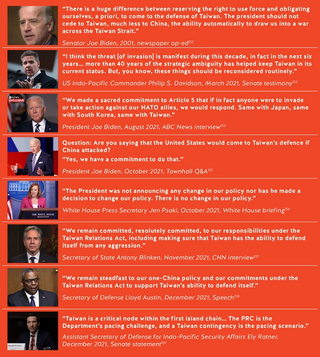
US regional economic statecraft
It is widely agreed across the Indo-Pacific that the lack of a robust US economic agenda is the weakest element of Washington’s regional engagement. In November 2021, National Security Council Indo-Pacific Coordinator Kurt Campbell called economics and trade “the coin of the realm.”160 Economic cooperation and trade integration remain the key enablers of China’s rising influence, but the United States has had little to offer as an alternative in recent years. Campbell added the United States needed to “step up its game” with an “open, engaged, optimistic approach to commercial interactions, investment in the Indo-Pacific” in 2022.161 It is promising the Biden administration recognises how far the United States has fallen behind the regional trend on economic cooperation. Yet, it is underwhelming that its answer appears to be a new and as yet ill-defined “Indo-Pacific Economic Framework,” as opposed to a plan to join the region’s existing trade blocs.
The Biden administration’s performance to date
Regional trade blocs are the Achilles’ heel of US Asia policy. If the “coin of the realm” is trade, as Campbell usefully notes, then free trade is the royal decree in the Indo-Pacific. States across the region continue to deepen trade ties with one another and with China. In January 2022, the Regional Comprehensive Economic Partnership entered into force as the largest trade bloc in the world. In light of China’s continuing trade disputes with Australia and cases before the WTO, not to mention the ongoing economic disruption wrought by the COVID-19 pandemic, it was striking that ASEAN, Australia, New Zealand, China, Japan, and South Korea all managed to ratify the agreement.
It is promising the Biden administration recognises how far the United States has fallen behind the regional trend on economic cooperation. Yet, it is underwhelming that its answer appears to be a new and as yet ill-defined “Indo-Pacific Economic Framework,” as opposed to a plan to join the region’s existing trade blocs.
China and Taiwan’s application to join the Comprehensive and Progressive Agreement for Trans-Pacific Partnership in September 2021 — with South Korea and the United Kingdom expected to follow suit — highlighted how the region is pressing ahead with trade integration in the United States’ absence. The Obama administration played an instrumental role in forming the Trans-Pacific Partnership (TPP) with 11 countries around the Pacific Rim based on high standards on workers’ rights, environmental protection, and transparency that set it apart from RCEP. Since the Trump administration’s withdrawal from the TPP in 2017 in the face of bipartisan opposition, the United States has found itself outside the region’s two largest trading blocs with little foreseeable prospects of re-joining.
To make matters worse, US economic statecraft during this time has been detrimental to its regional allies and partners. Elected on a promise to “build back better” domestically from the pandemic, Biden’s economic agenda still retains many of his predecessor’s protectionist policies around tariffs, quotas and job protection.162 For example, US Trade Representative Katherine Tai referred to “reshoring” and “friend-shoring” key industries back to the United States.163 The administration’s protracted negotiations with Japan and South Korea over steel tariffs,164 and data-sharing demands from their semiconductor manufacturers demonstrated even close allies are not immune to these US domestic pressures.165 In addition, President Biden’s Executive Order 14005 also strengthens the 70-year-old “Buy American” statute, making it harder for foreign companies to participate in US Government procurement contracts and posing an obstacle to deeper defence industrial integration with allies.166
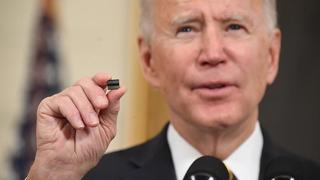
Instead of free trade, the Biden administration has offered a piecemeal regional economic agenda under the label of an “Indo-Pacific Economic Framework.” Though still in the making, the framework is expected to emphasise issues that have traditionally not been the primary focus of regional trade agreements, including the digital economy, energy and climate policies, and labour and environmental standards.167 In contrast, Commerce Secretary Gina Raimondo has hinted that the framework will have a more targeted focus on bringing semiconductor production back to the United States, harmonising export controls among allied countries to limit “sensitive products” from going to China, and updating technical standards for artificial intelligence and cybersecurity.168 These mixed signals and the administration’s incremental approach to developing the framework are inadequate to regain US initiative on economic cooperation. The framework seems more focused on what the United States wants from Asia — niche sectoral cooperation together with the decoupling of critical industries from China — than what Asia needs, which is trade liberalisation and increased market access.
Furthermore, the Biden administration’s framework is unlikely to offer anything as attractive as RCEP or CPTPP. Greater export market access and investment remain the key priorities for most of the developing economies in Southeast Asia. China continues actively increasing much-needed trade, investment and development financing in Southeast Asia.169 It is unlikely that the framework will include most Southeast Asian countries if it focuses on digital economy, clean energy, worker standards and other issues mostly relevant to developed economies.170 As former Obama officials Danny Russel and Wendy Cutler recently argued, “the fact remains that however much the Framework succeeds in strengthening US economic engagement in the region, it is unlikely to be viewed as a convincing alternative to the CPTPP, which has steadily garnered credibility and appeal.”171
Key takeaways and implications for Australia
Given these shortcomings, prospects for a return to US regional economic leadership are dim, especially ahead of the November 2022 midterm elections where campaigning over protecting domestic jobs will be prominent and free trade could potentially be used as a wedge. Australia has worked hard to impress upon the United States its crucial role in regional economic leadership.172 Together with other US allies and partners, Australia must continue to make the case for why US participation in regional trade agreements is beneficial domestically as well as for the region at large. In the absence of US participation, Australia should endeavour to actively shape the RCEP and CPTPP to make them as attractive as possible to potential US, not to mention Indian, membership in the future. This will require closer coordination with the region’s other economically developed states, such as Japan, South Korea and Singapore.
Australia will need to support the framework as far as possible when it is released, while actively shaping its final agenda to be relevant and appealing to the region, including by making sure that infrastructure development efforts currently being pursued under the G7’s Build Back Better World initiative complement the framework’s more selective agenda. Australia can also push forward on niche bilateral and minilateral projects with the United States where there is greater US domestic support, such as rare earth minerals, renewable energy and emerging technologies. For Australia, these trends present an opportunity to deepen economic cooperation within the Australia-US alliance.173 But the bigger picture suggests that the United States will continue to compete for influence with its economic hands tied behind its back.
Free Trade Agreements (The Coin of the Realm)
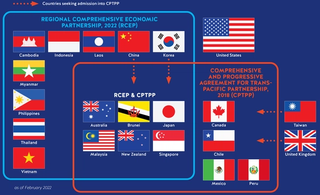
Methodological appendix
Please download the PDF version of this report to view the methodological appendix.





